1874 harbound "tunnels and water system of chicago" book latest addition to bldg. 51 archive
This entry was posted on November 4 2022 by Eric
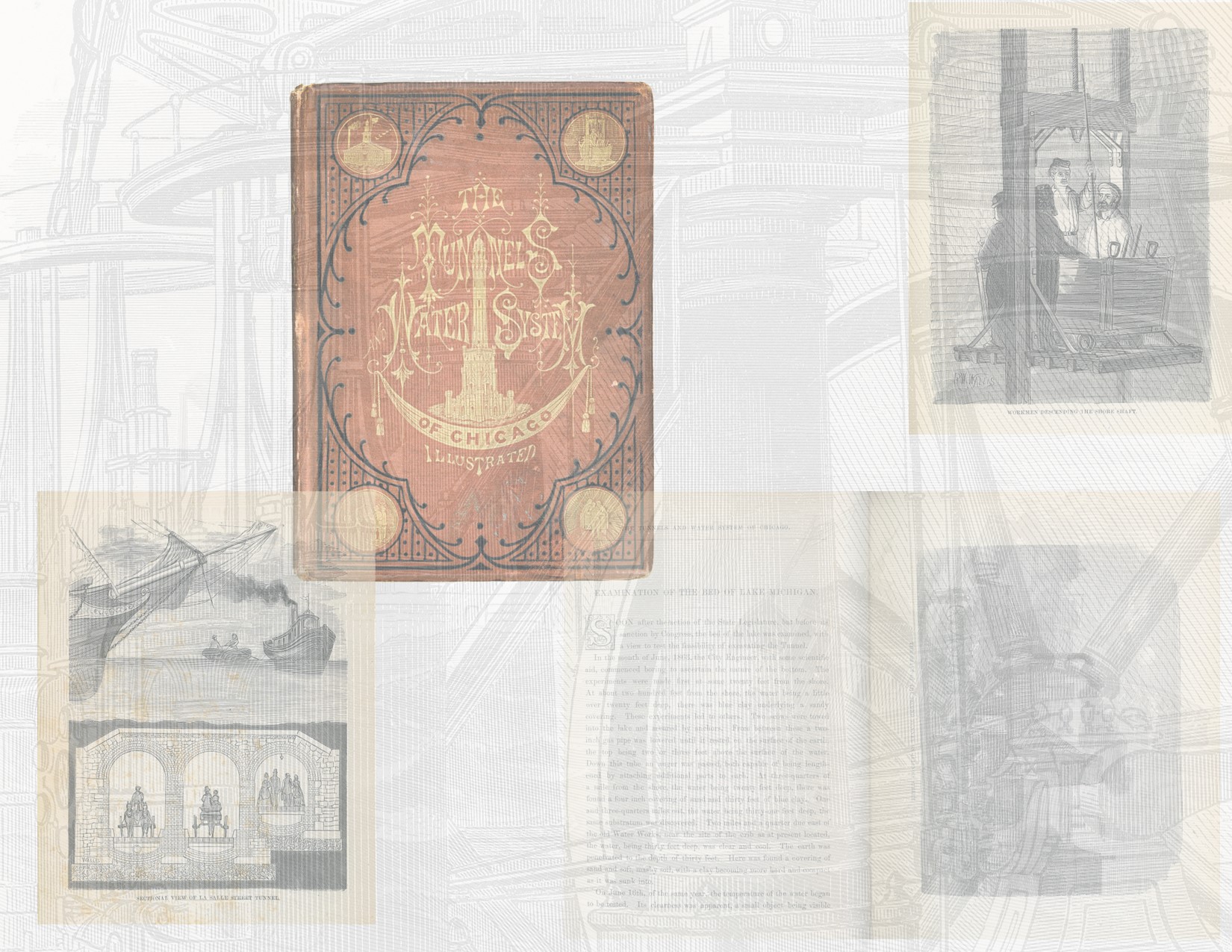
the bldg. 51 archive just acquired an original hardbound copy of tunnels and water system of chicago: under the lake and under the river, chicago : j.m. wing, 1874. cover and lithographic plates below.
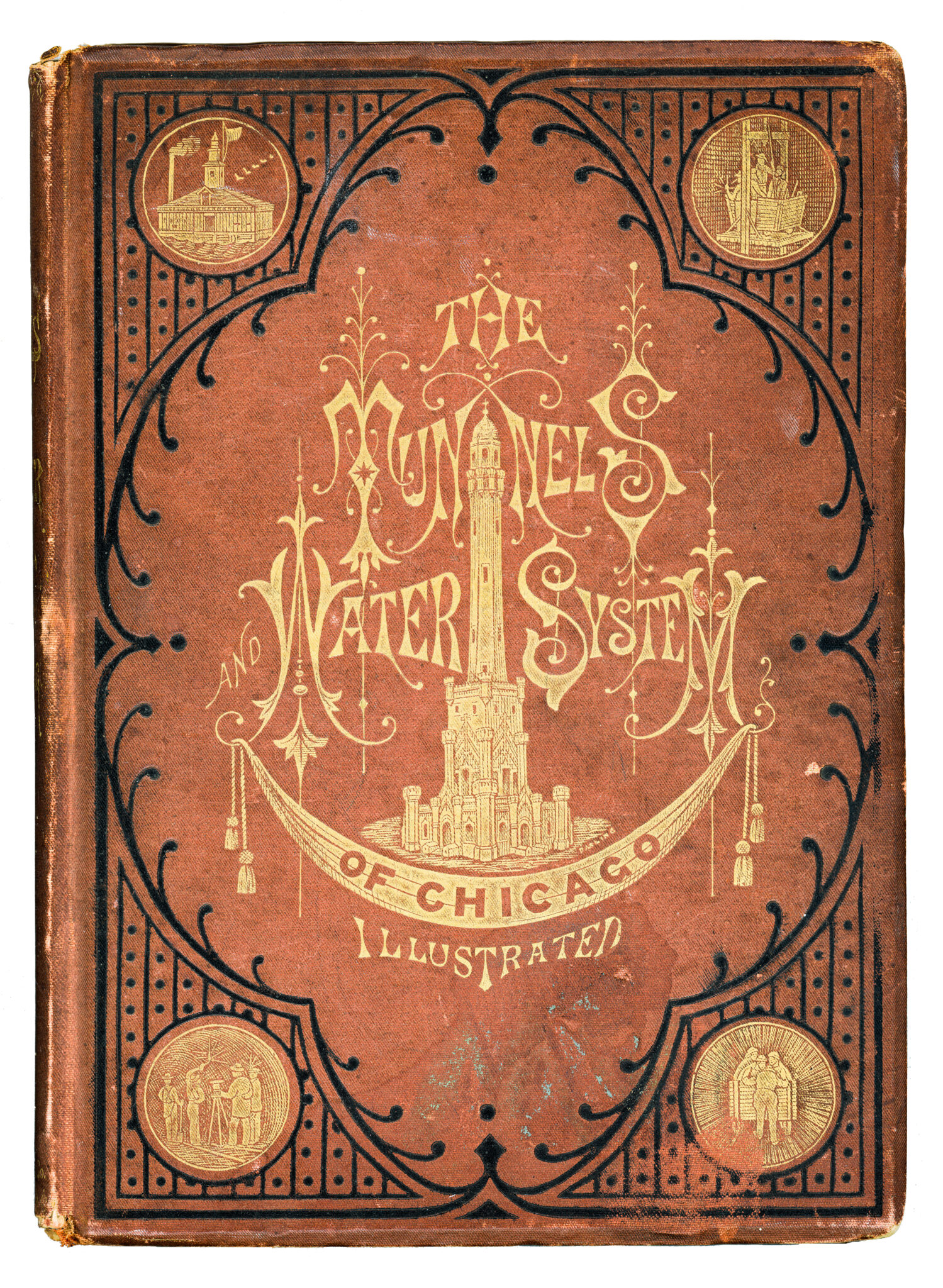
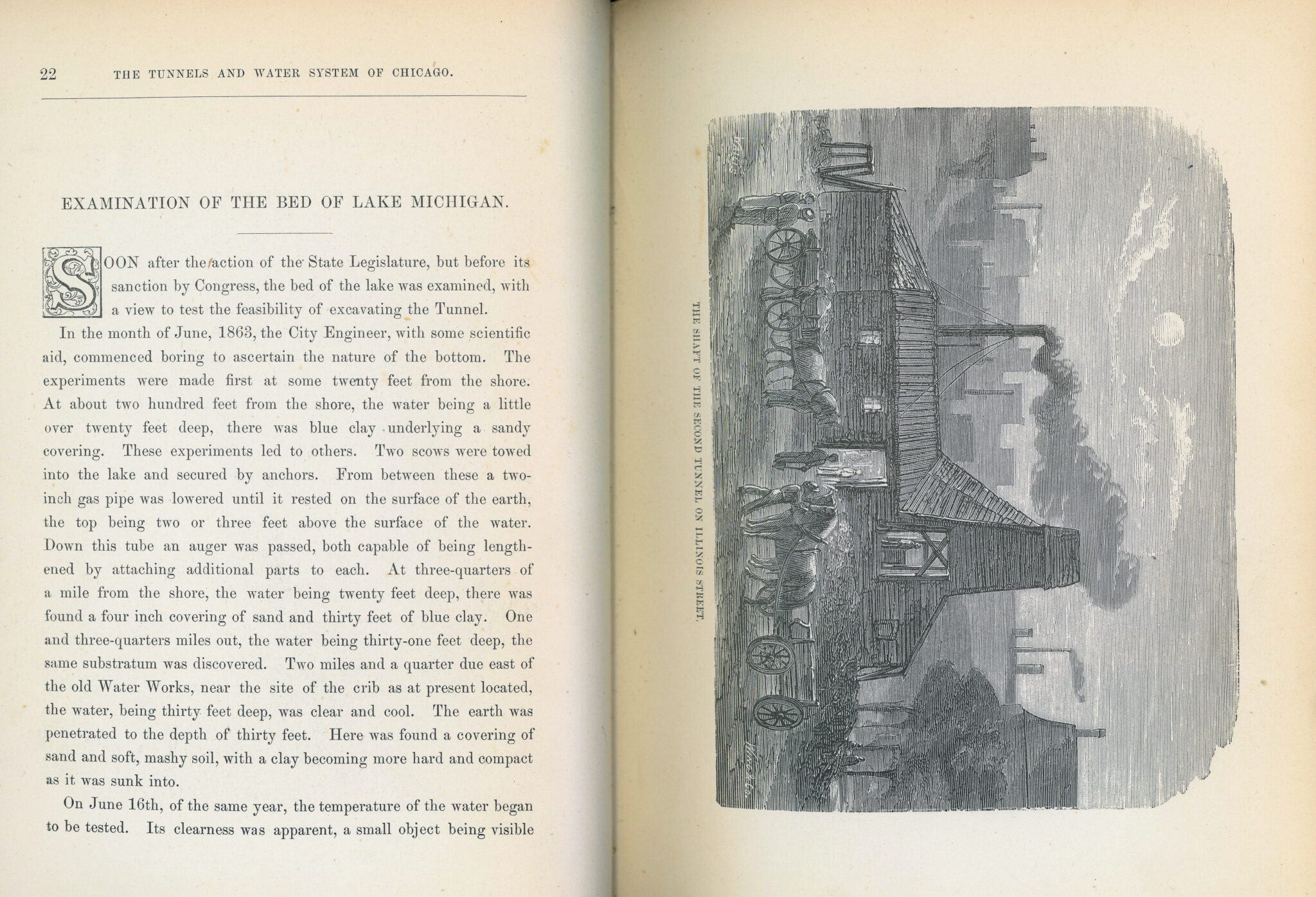
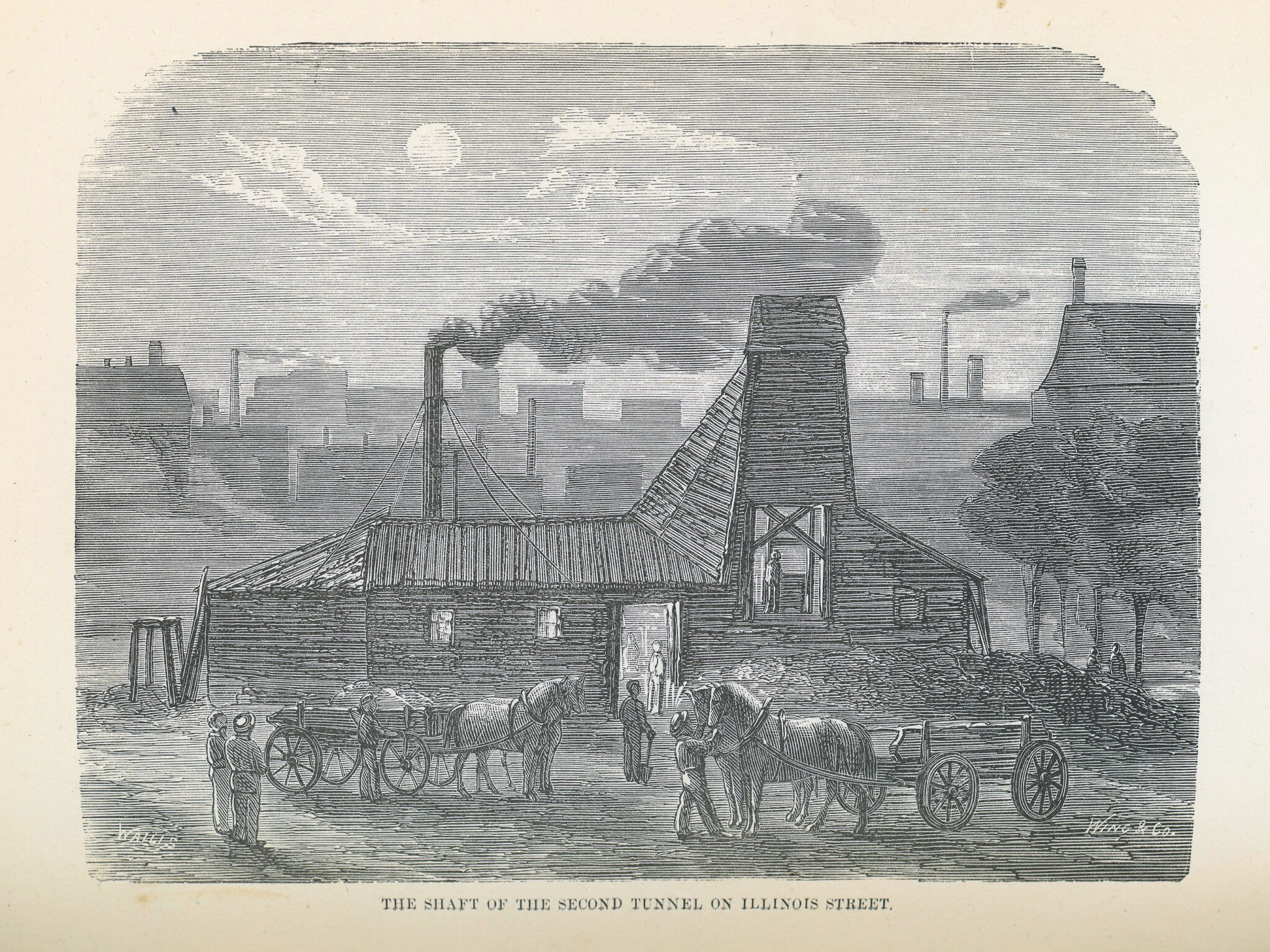
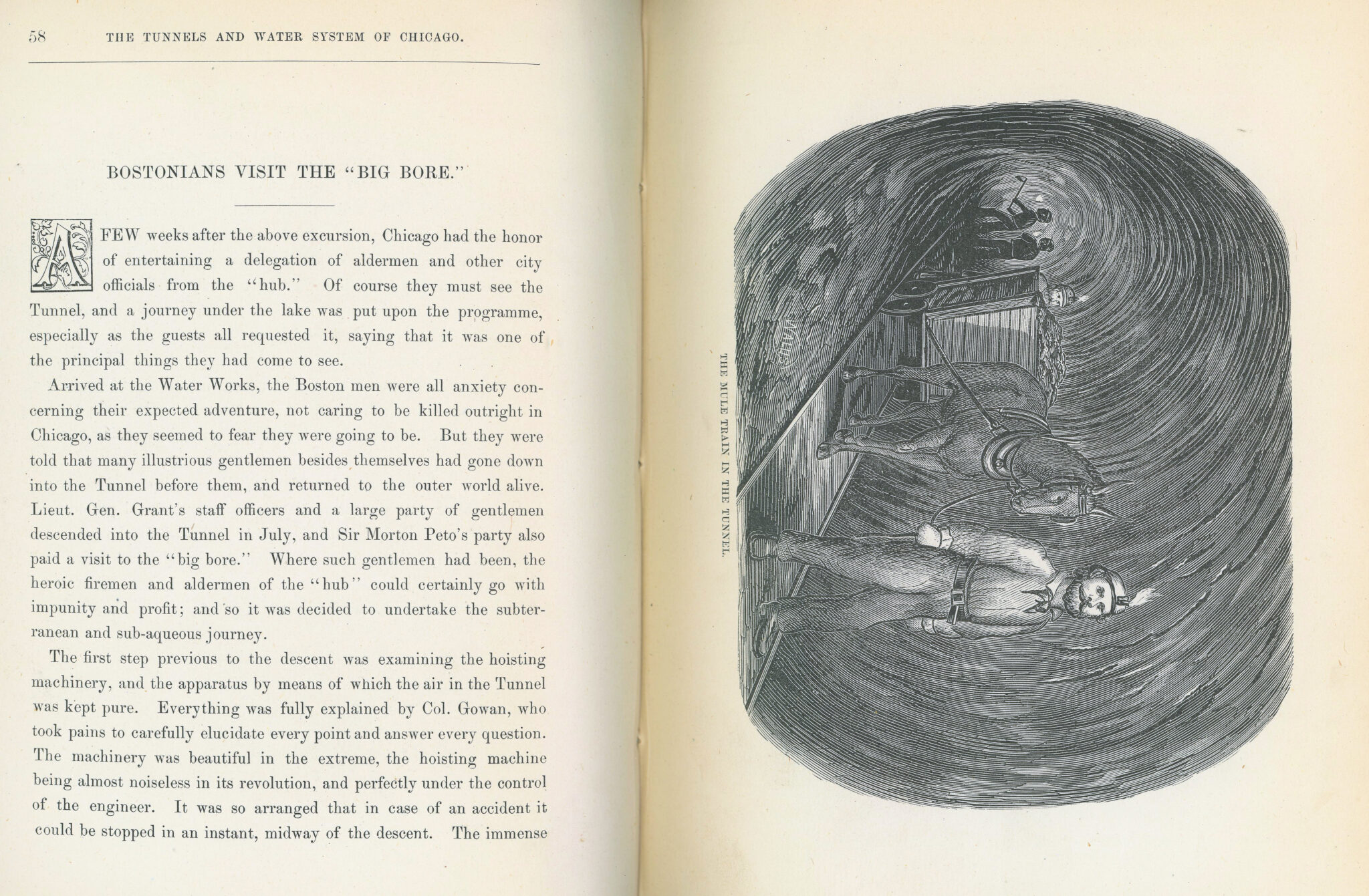
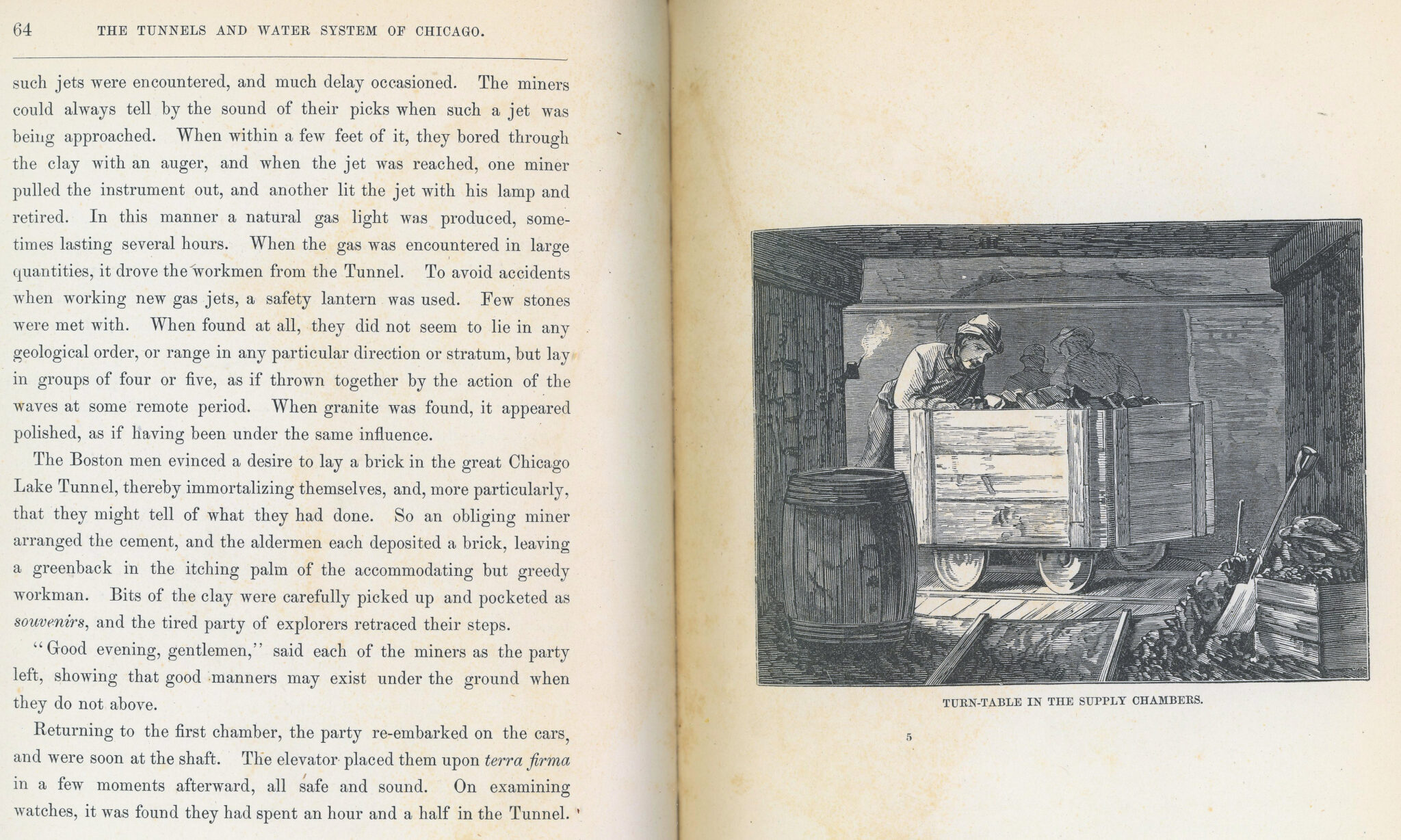
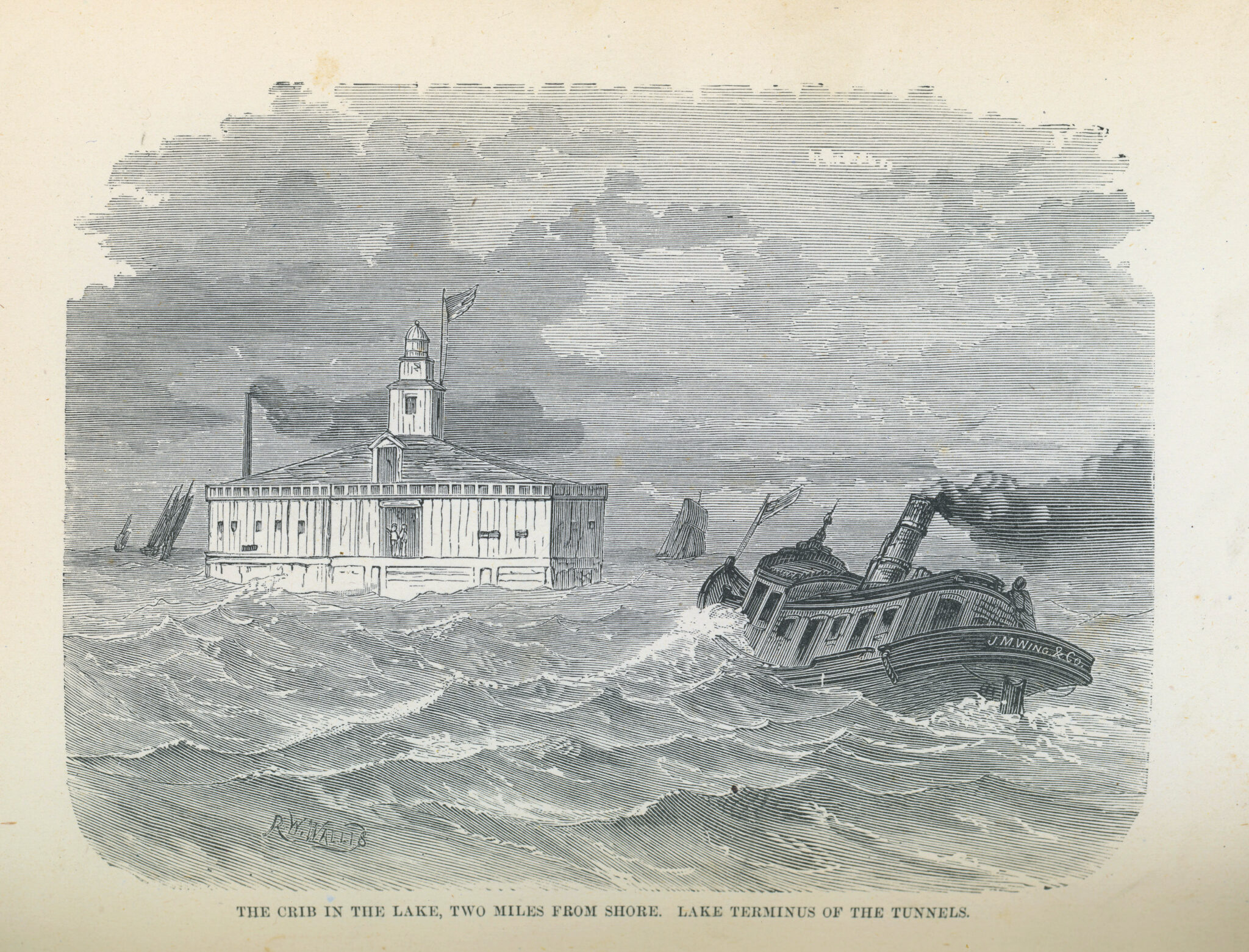
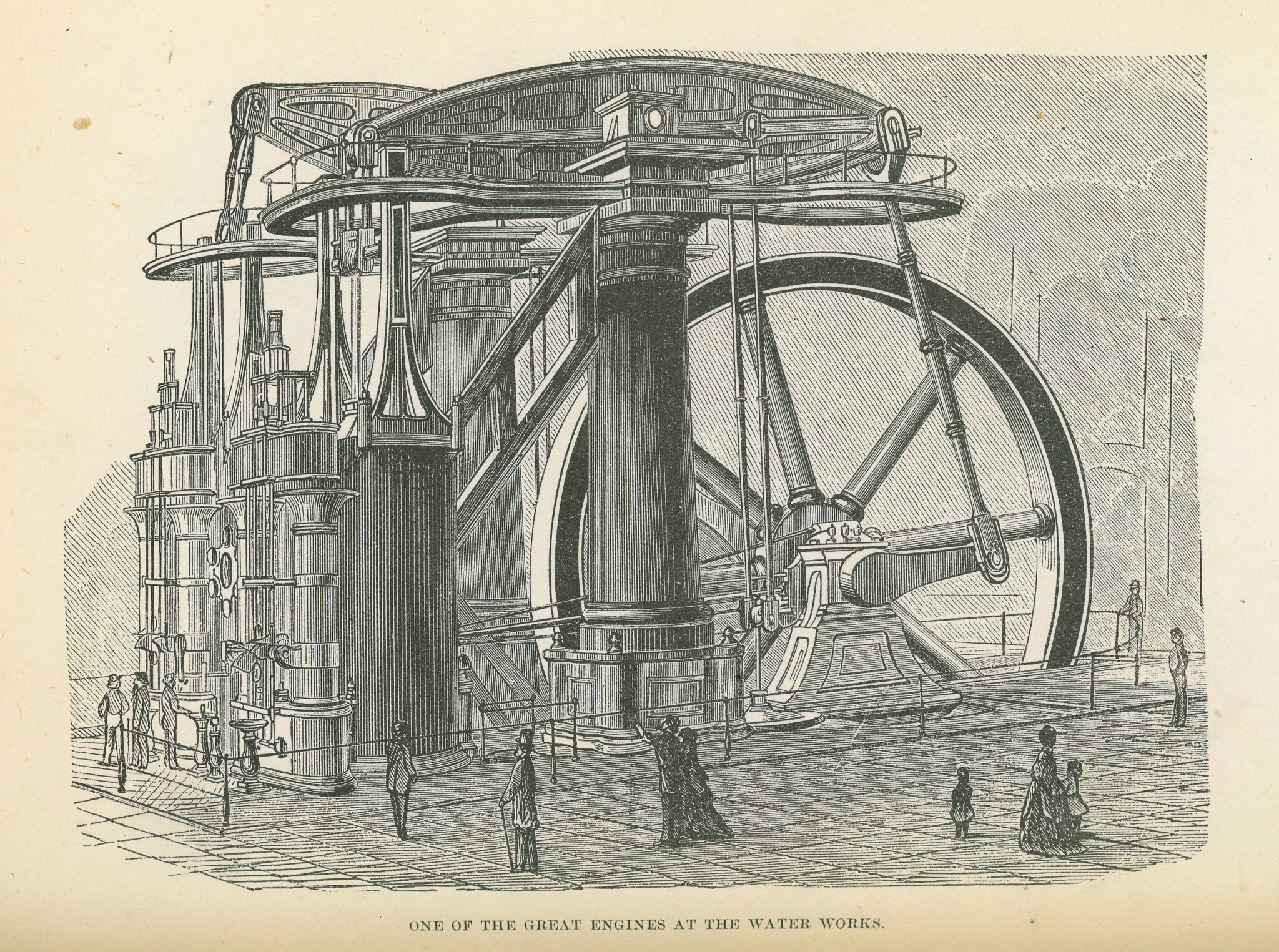
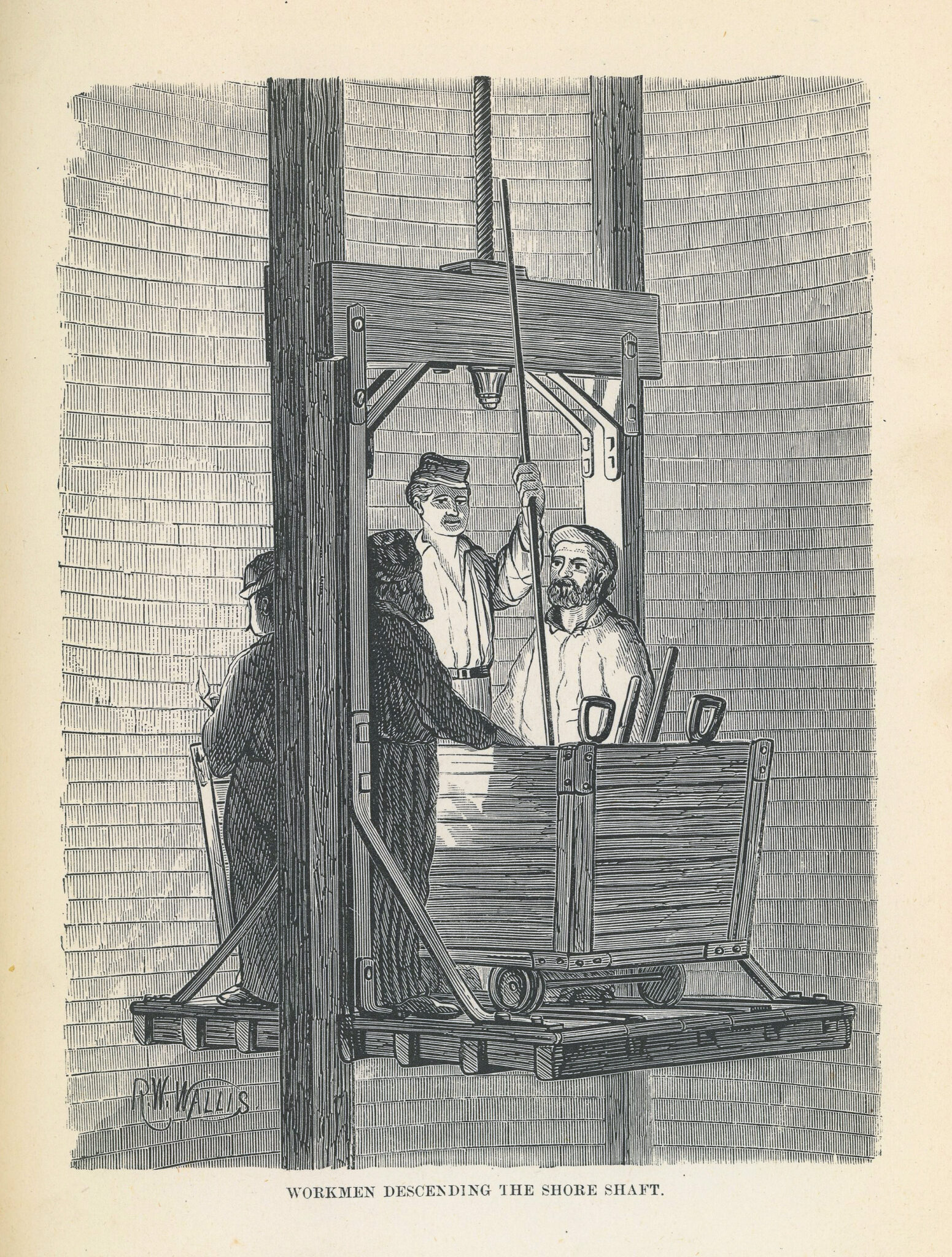
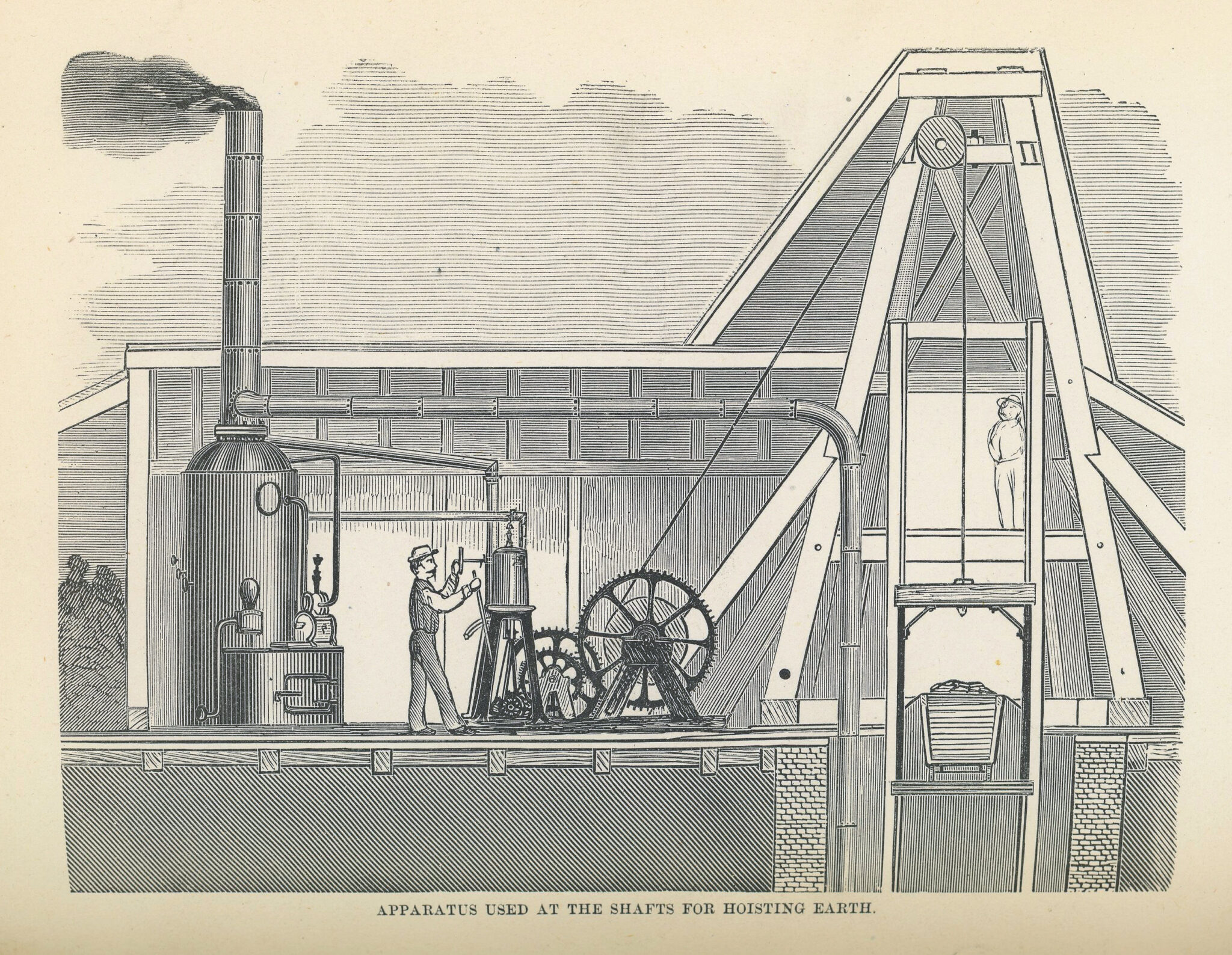
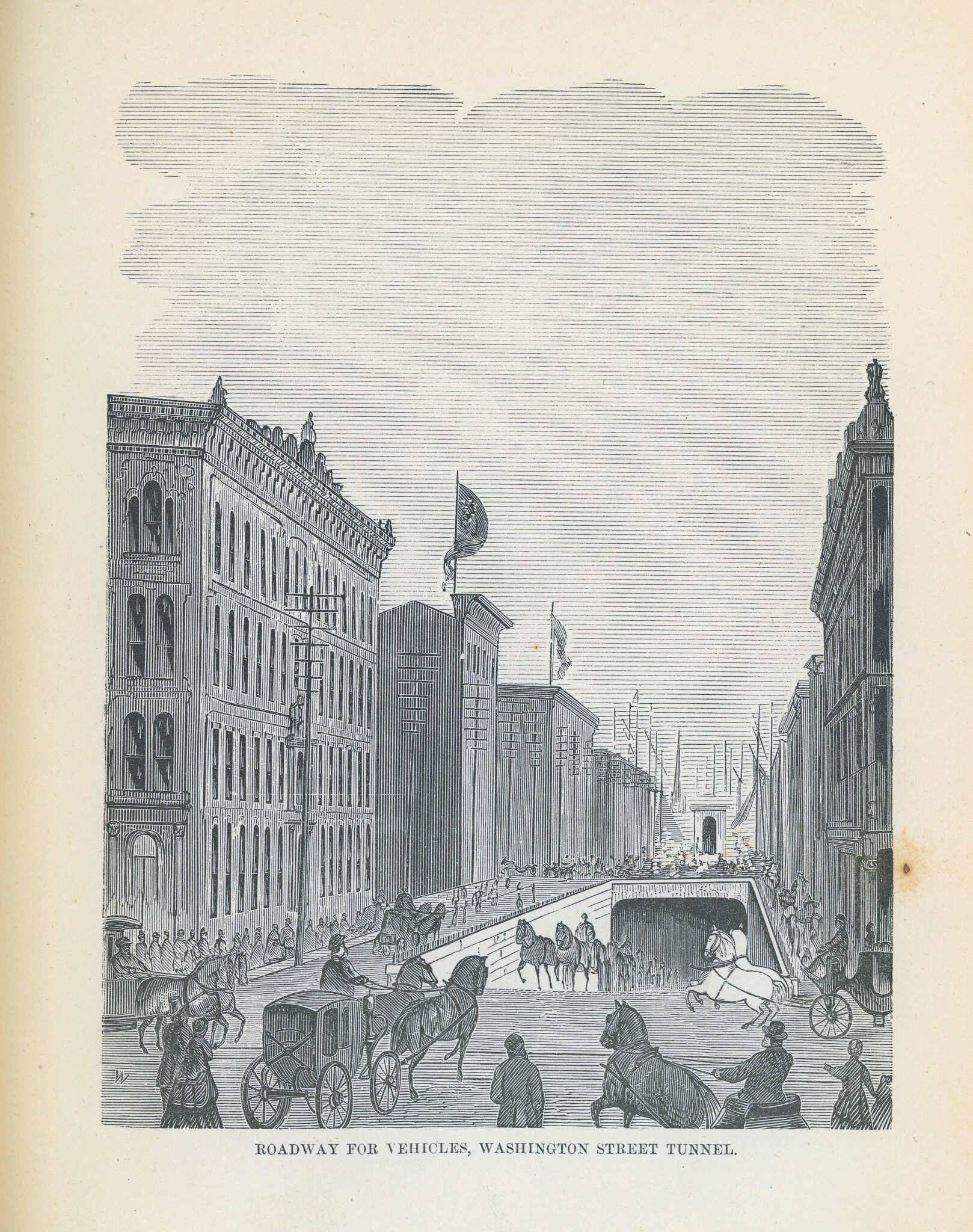
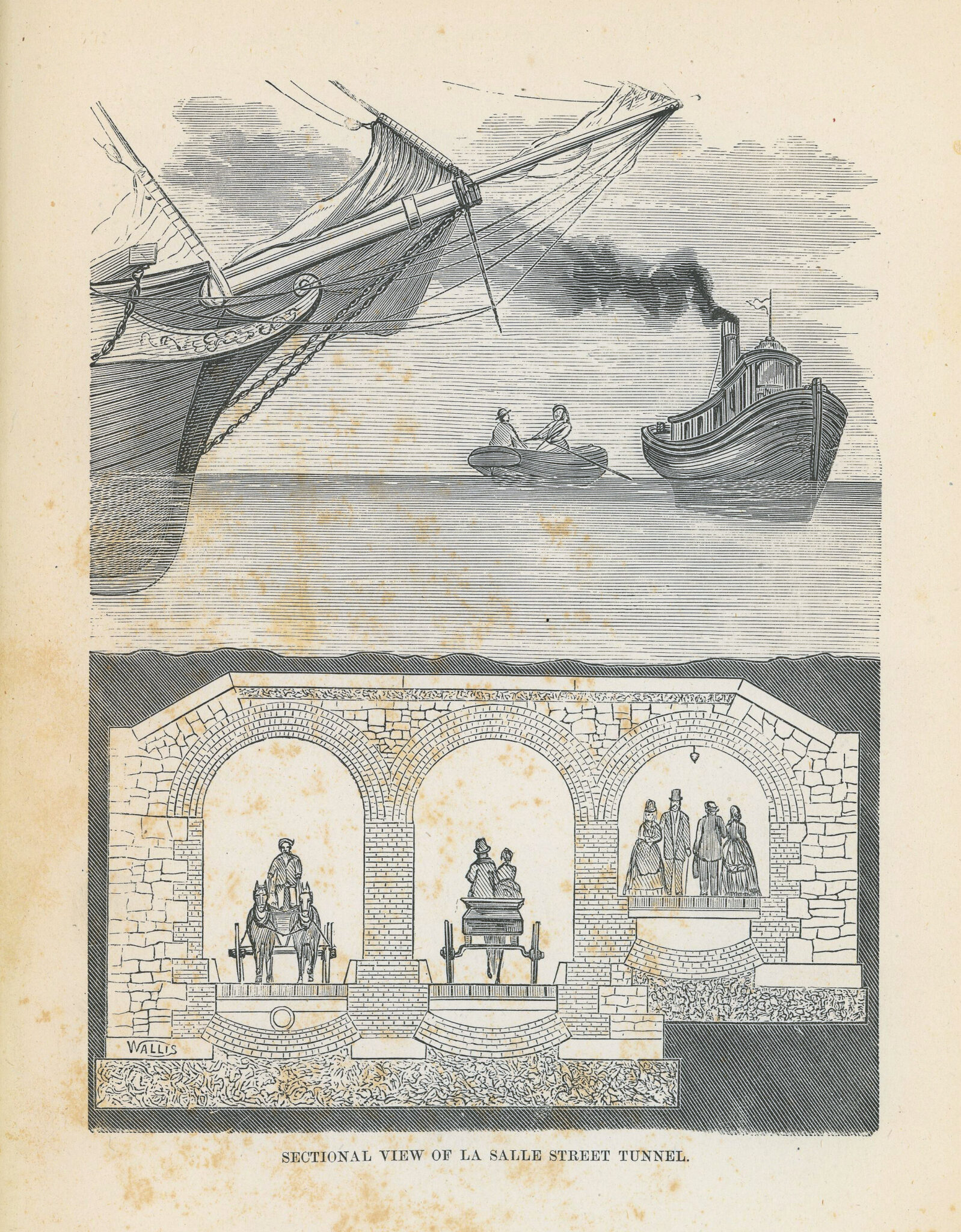
further reading (from documentary history of american water-works):
The Chicago Hydraulic Company was incorporated in 1836 by James B. Campbell, Gholson Kercheval, Robert A. Kinzie, Richard I. Hamilton, Henry G. Hubbard, David Hunter, Peter Cohen, Ed. W. Casey, Gurdon S. Hubbard, G.W. Dole, John H. Kinzie, William Forsythe, and Solomon Wills to introduce water from Lake Michigan into the town of Chicago. The term of the charter was 70 years and the capital stock set at $400,000. The Panic of 1837 delayed construction for some time, but it was finally begun in 1840. The Chicago Common Council contracted with the Hydraulic Company in December, 1841 to supply the city with water for the extinguishment of fires, and a schedule of rates for domestic and manufacturing customers was published in April, 1842, and ranged from $10 per annum for a family of five persons, to $500 for large services in manufactories. The pipes from the mains to buildings were furnished at private expense. In 1842 James Long entered into an arrangement with the Company to do their pumping for ten years without cost in return for the free use of the surplus power of their engine, which he used to run a grist-mill. The system began service in May of 1842, drawing water from Lake Michigan through a 150 foot iron pipe. According to a local newspaper account, the machinist who made the system work successfully was Ira Miltimore.
The Lake Michigan Hydraulic Company was incorporated in 1845 by Thomas Dyer, William B. Ogden, William E. Ives, Walter L. Newberry, Henry Smith, Mahlon D. Ogden, John H. Kinzie, and John B. Turner "to supply by hydraulic works, the water of Lake Michigan to the people living on the north side of the Chicago river only. This charter would only take effect if the Chicago Hydraulic Company did not make arrangements to serve the area north of the Chicago River within six months. An 1847 amendment gave the company "the right to use any surplus steam or other power which they may create or form to carry on the manufacture of flour, lumber, woolen or cotton goods, or such other kinds of mechanical or manufacturing business as they may deem proper." No evidence has been found that this company built anything.
The Chicago City Hydraulic Company was incorporated in 1851, with John B. Turner, Horatio G. Loomis and Alson S. Sherman appointed as the initial commissioners to serve terms of three, four, and five years, at which times their successors would be elected. The commissioners engaged engineer William J. McAlpine, who had earlier built new water works in Albany, to design the new system in Chicago. The plan adopted by the commissioners included a steam pumping plant drawing water from the lake through a 30-inch diameter wrought-iron inlet pipe extending 600 feet into the lake, three elevated iron reservoirs, and cast iron distribution pipes. City voters approved the plan on March 2, 1852 by a vote of 2,688 to 513, with 1,245 voters not expressing a preference. The Chicago common council authorized the commissioners to pay the Chicago Hydraulic Company $30,000 for their system or $15,000 for their franchise, but the company sought an injunction to prevent the city from building the system. This failed, and the judge in the case said there appeared to be no requirement to buy the company's system or franchise, but the city ended up buying the company for $15,000 around 1855. (see 1866 "Chicago Water Works" reference.).
The city's system began operating in February 1854 with a set of condensing and non-condensing pumping engines located in a new building at the foot of Chicago Avenue. A 30-inch pine stave pipe was substituted for the proposed wrought iron pipe, probably due an increase in the cost of iron. This was supplemented with a 3 x 4 foot wooden inlet aqueduct in 1855. The pumps supplied water to an 80-foot wrought-iron standing column, one of the earliest stand-pipes built in the country. This column absorbed shock from the single-cylinder pumping engines and maintained a constant pressure on the distribution piping to keep the remote reservoirs filled. McAlpine envisioned three remote reservoirs, but only the south one was built initially at the corner of Adams and LaSalle street. It held 500,000 gallons in a circular wrought-iron tank installed on top of a two-story stone building, but the tank unfortunately failed during its public demonstration in November, 1854 and had to be reinforced. Similar reservoirs were built in 1858 at Morgan and Monroe streets and Chicago Avenue at Sedgwick street. The non-condensing pumping engine was replaced in 1857 with a larger condensing engine. The pumping station, distribution system, and the reservoir at Morgan and Monroe streets are shown below:
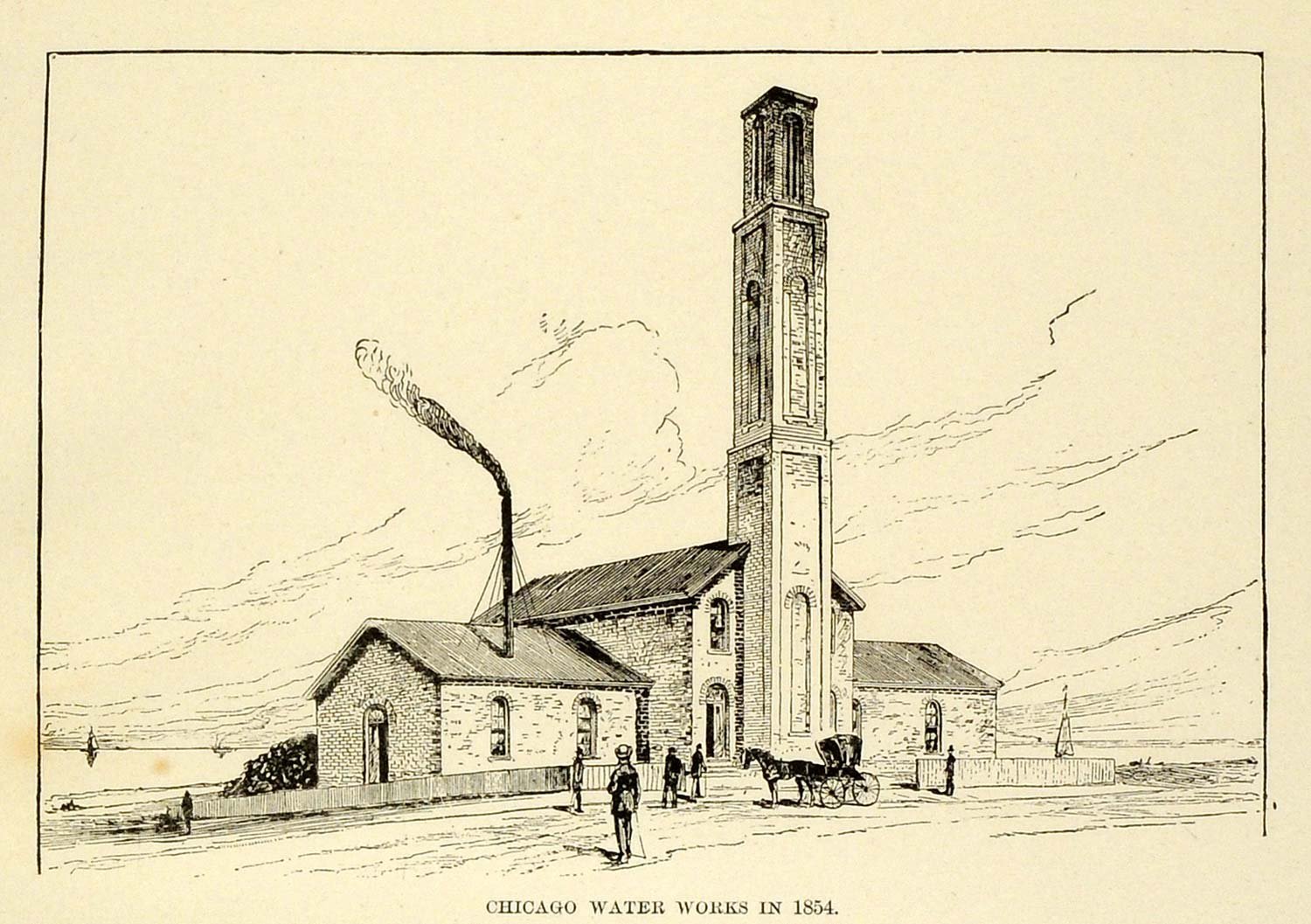 |
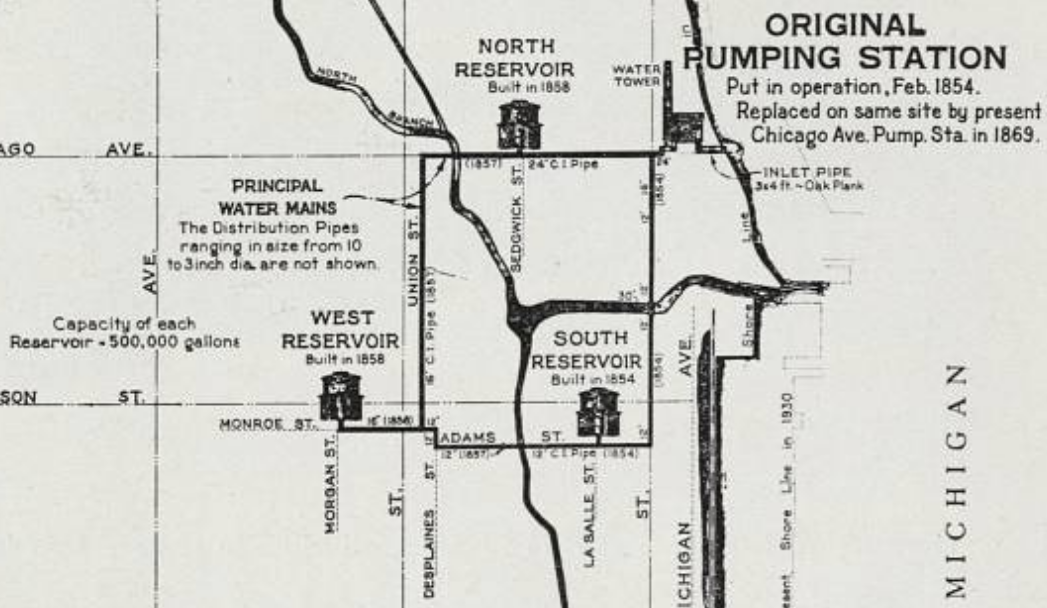 |
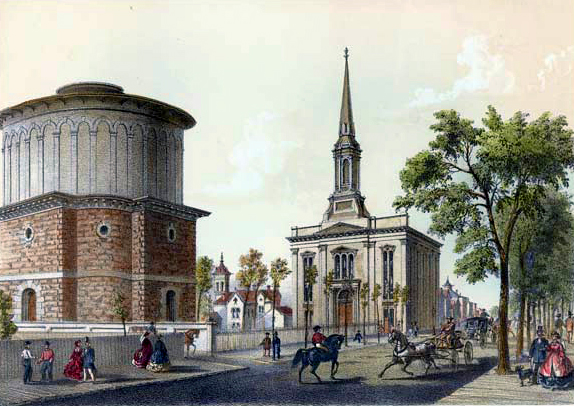 |
| Chicago Water works |
A Century of Progress in Water Works: Chicago 1833 1933, page 35 | “Second Baptist Church,” by Louis Kurz (July, 1866) |
On May 6, 1861 the Board of Public Works was established with Ellis S. Chesbrough as Chief Engineer and assumed the responsibilities of Board of Water Commissioners. They decided to built a two-mile long tunnel under Lake Michigan in 1863, which was completed in 1867. A second, larger and longer lake water tunnel was completed in 1874, along with rebuilding the pumping station which was completed in 1869.
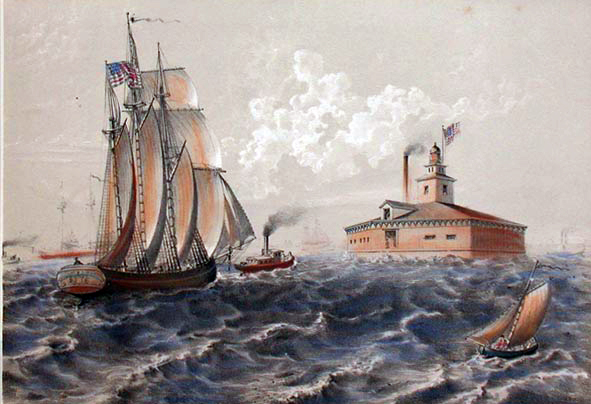 |
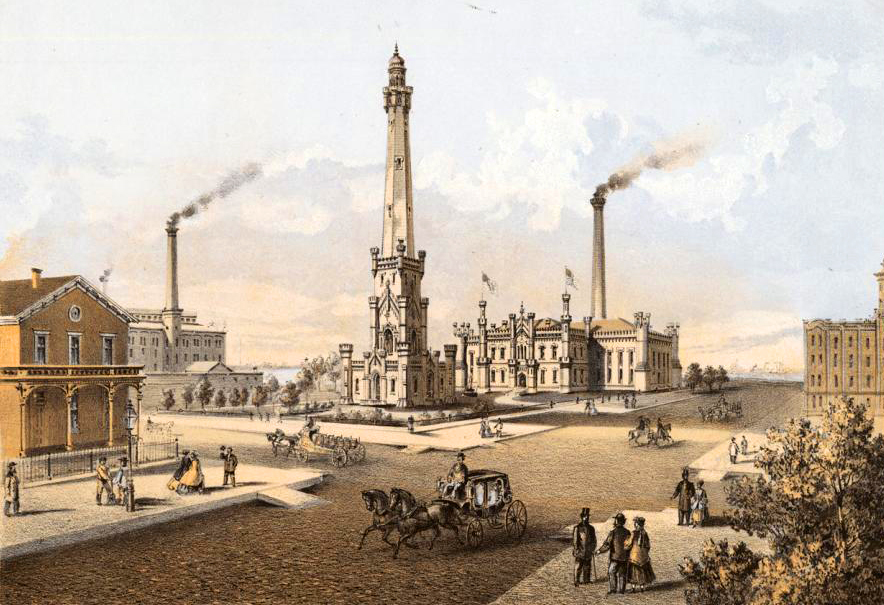 |
| "The Chicago 'Crib'" by Louis Kurtz (August, 1866) | "Water Works," by Louis Kurtz (January, 1867) |
Unfortunately, the water works building had a wooden roof, which caught fire and collapsed during the Chicago Fire of October 8-10, 1871. One of the engines was repaired and operating again in ten days.
On September 19, 1876, the Department of Public Works was established. The city acquired several other water systems through annexation, including Lake View, Lake, and Hyde Park.
Pumping capacity of Chicago water works (Million of gallons per day):
| Year | 1842 | 1854 | 1858 | 1868 | 1873 | 1878 | 1884 | 1888 | 1890 | Current |
| Pumping Capacity | 1 | 8 | 20 | 38 | 74 | 104 | 134 | 158 | 260 | 1,000 |
Water is provided by the City of Chicago.
References
1836 An act to incorporate the Chicago Hydraulic Company. January 18, 1836.
1842 Mayor Benjamin Wright Raymond Inaugural Address, March 7, 1842
I trust the Hydraulic Company will be prepared to supply the most populous portions of the city with water for the extinguishment of fires early in May next, which will, no doubt, prove an efficient auxillary to the Engine Companies.
1842 Daily Chicago American, May 24, 1842. Reprinted in History of Cook County, Illinois--: Being a General Survey of Cook County History, Including a Condensed History of Chicago and Special Account of Districts Outside the City Limits; from the Earliest Settlement to the Present Time, Volume 1, Edited by Weston A. Goodspeed and Daniel D. Healy. (1909)
Much to the gratification of our citizens, the works of the Chicago Hydraulic Company are at last in successful operation.
1842 The Chicago Hydraulic Company, Chicago Daily American, June 10, 1842.
Rapidly advancing as is our city in prosperity, the undertaking and completion of the Hydraulic works was, nevertheless, a serious enterprise, and was regarded by many as a hazardous experiment. The spirit with which the work has been carried on by the present stockholders, is highly creditable to them. It is a great public improvement and has already proved to be of decided utility. We notice that the water as drawn from the faucets is decidedly pure and transparent. Some account of the works, &c., will not, perhaps, be uninteresting to our readers. The whole outlay of the company has been about $24,000. A large two story brick building has been erected, with a pier running into the lake. The steam engine is twenty-five horse power. The working barrel of the pump is fourteen inches in diameter and forty-four inch stroke — double action. The suction pipe — the pipe by which the water is drawn from the lake — is also fourteen inches in diameter and 320 feet in length. The pump raises upwards of twenty-five barrels of water per minute, thirty-five feet above the level of the lake. There are two reservoirs, each of the capacity of 1,250 barrels, only one of which is complete. A space of about fifty minutes is required to fill a reservoir—equivalent, of course, to raising 1,250 barrels in fifty minutes. The reservoir is of sufficient elevation to throw the water into the second story of any building in the city. About two miles in length of pipe are now laid down. The machinist under whose direction these works have been put into such complete and successful operation is Mr. Ira Miltimore. We allude to this gentlemen with the more pleasure that it was for a long time confidently predicted that his undertaking would prove an entire failure. We know that, thought he had perfect confidence in his ability to accomplish the task, these predictions were to him a source of constant and harassing anxiety. It can scarcely be imagined how keenly intense were his feelings when, the works compete, they were upon the point of being put into operation. The triumph, or it might be the disgrace, of the mechanist was at hand. His feelings at that moment were, assuredly, not to be envied. They were to be envied when the regular evolution — the easy play — the harmonious action of eery part of the machinery, announced the complete triumph of skill.
1845 An act to incorporate the Lake Michigan Hydraulic Company, March 1, 1845.
Sec. 10. This act shall not take effect in case the "Chicago Hydraulic Company," now in operation in the city of Chicago, shall within six months from the passage of the same, commence the necessary arrangements, to furnish water for the use of the inhabitants on the north side of the Chicago river, and shall within twelve months thereafter be prepared to, and shall supply the inhabitants generally in that part of the city aforesaid, water upon such usual and established terms and prices as the said company may from lime to time legally adopt.
1847 An Act to amend an act entitled an act to incorporate Lake Michigan Hydraulic Company, February 28, 1847. | Summary here |
1851 An act to incorporate the Chicago City Hydraulic Company. February 15, 1851.
1851 Report made to the Water Commissioners of the City of Chicago, September 26, 1851, on supplying the city with water by William J. M'Alpine, Civil Engineer.
1852 An act to amend an act entitled "an act to incorporate the Chicago City Hydraulic Company." June 15, 1852.
1852 Third semi-annual report of the Board of Water Commissioners, of the City of Chicago, to the common council of the city of Chicago. January 15, 1853.
1853 Annual Report of the Board of Water Commissioner of the City of Detroit. In 1853, the new Board of Water Commissioners of the City of Detroit sent superintendent Jacob Houghton, Jr. to visit and report on water works in other cities, including Chicago.
Pages 25-26: Chicago - The city of Chicago, for the last two years, has been engaged in constructing Water Works, which are now so far advanced, that they will be brought into use within a few days.
An inlet pipe, made of pine staves, thirty inches diameter, is extended into Lake Michigan, a distance of six hundred feet, through which water is supplied to the pump well, from which it is elevated, by means of two steam engines (a condensing and a duplicate non-condensing), into a reservoir at a height of eighty feet.
For the want of elevated ground, they are compelled to make use of a tower and tank similar to the one in use at Detroit. The tank is made of boiler iron, braced across its centre with wrought-iron rods, is sixty feet diameter, twenty-eight feet deep, and contains about four hundred and ninety-three thousand gallons. Other reservoirs, of like capacity, will be constructed as required.
The works are calculated to furnish a daily supply of three millions of gallons, and have cost about $400,000. The unprecedented growth of that city will probably require the immediate extension and enlargement of the works.
1853 Albany Evening Journal, December 21, 1853, Page 2.
Chicago Water Works.- We are informed that the Chicago Water works, built under the supervision of Wm. J. McAlpine, Esq., went into operation on Monday last. They worked beautifully, and to the entire satisfaction of the public.
1853 Fifth semi-annual report of the Board of Water Commissioners to the common council of the city of Chicago. January, 1854. No copy of this has been found.
1854 Milwaukee Daily Sentinel, November 25, 1854, Page 2.
Damage to the Chicago Water works.- We learn from the Chicago Democrat that the new Reservoir building in that city has given way, and tumbled into ruins, making a loss to the city of $60,000.
1854 "Squashed Out," The Moline Workman, November 29, 1854, Page 2.
Chicago reservoir failure.
1854 Portage County Democrat (Ravenna, Ohio), December 13, 1854, Page 3.
The new reservoir of the Chicago water-works, built at a cost of $60,000, was tested on Wednesday, and gave way. The probability is, that the work will have to be done entirely over again.
1854 Seventh semi-annual report of the Board of Water Commissioners to the common council of the city of Chicago. December 31, 1854.
1854 "Chicago Water Works," from Annual Review of the Trade and Commerce of Chicago
1855 An act to enable the Chicago Hydraulic Company to sell their property and collect their demands. February 14, 1855.
1855 An act in amendment of an supplemental of an act entitled "An act to incorporate the Chicago City Hydraulic Company." February 14, 1855.
1856 Eleventh Semi-annual report of the Board of Water Commissioners to the Common Council of the City of Chicago, January 1, 1857.
1857 An act to amend an act entitled "An act in amendment of 'an act to amend the Chicago Hydraulic Company.'" February 16, 1857
1857 Thirteenth Semi-annual report of the Board of Water Commissioners to the Common Council of the City of Chicago, January 1, 1858.
Page 5: The small non-condensing engine is not now in use; it has been removed from the engine house and is for sale.
1858 Fifteenth Semi-annual report of the Board of Water Commissioners to the Common Council of the City of Chicago, January 1, 1859. From The Library Company of Philadelphia.
1859 Seventeenth Semi-annual Report of the Board of Water Commissioners to the Common Council of the City of Chicago, February 24, 1860.
1860 "Water Taxes," Chicago Tribune, October 22, 1860, Page 1.
We understand also that by a recent order of the Board, parties taxed for buildings in the water district not supplied with water, have been made to them a discount of twenty percent. if the assessment is paid in November.
1860 Nineteenth Semi-annual report of the Board of Water Commissioners to the Common Council of the City of Chicago, January 1, 1861.
1861 First Annual Report of the Board of Public Works to the Common Council of the City of Chicago. January 1, 1862.
1862 Guide Map of Chicago. This map shows the water works and three reservoirs.
1863 Second Annual Report of the Board of Public Works to the Common Council of the City of Chicago. April 1st, 1863.
1863 An ordinance authorizing the construction of a tunnel under Lake Michigan. October 5, 1863. | Specifications for Lake Tunnel |
1863 Improvement in filters and coolers, by G. B. Davis of Chicago, US patent # 40329, October 20, 1863. Domestic water filter referred to in 1876 reference below, also see 1865 reference.
1864 Third Annual Report of the Board of Public Works to the Common Council of the City of Chicago. For the Municipal Fiscal Year Ending March 31st, 1864.
1864 San Jose Mercury (San Jose, California), July 7, 1864, Page 1.
The great water-works tunnel at Chicago progresses. The iron portion of the shore shaft has been sunk, and has reached the expected shore clay. There is every reason to expect that the tunnel will pass through a uniform stiff clay, in which case the operations of the workmen will be easy. The clay is found to be of excellent quality for making bricks, and it is now planned to make the bricks required for the tunnel out of the clay excavated, this effecting a great saving.
1864 "Chicago Water Works. Semi-Annual Water Tax, Due Nov. 1, 1864," Chicago Tribune, October 25, 1864, Page 1.
On the water assessments on lots where the water is not used, a discount of twenty per cent will be made if the same in paid during November.
1865 "Davis' Union Water Filter," advertisement from Prairie Farmer, New Series 16(18):331 (October 28, 1865).
1866 "The New Chicago Water-works for Supplying Pure Water from Lake Michigan," Frank Leslie's Illustrated Newspaper, 23(579):100-101 (November 3, 1866).
1866 "Chicago Water Works - The Water Supply in the Past and Present - Historical Sketch," The Chicago Republican, November 26, 1866, Pages 2-3. This is an excellent summary of the history of the early water systems in Chicago.
1866 Laws and Ordinances Governing the City of Chicago
1866 “Second Baptist Church,” by Louis Kurz, from Chicago Illustrated, Part 7. (July, 1866) | also here | and here | Kurz also produced engravings of the inlet crib and new water works building
Second Baptist Church is located at the south-west corner of South Morgan and Monroe Streets. On the left of the picture is a view of one of the City Reservoirs. There has not been much pains taken to make the building ornamental. Its capacity is 500,000 gallons.
1867 "Chicago Water-Works," Harper's Weekly 11:251-252 (April 20, 1867) | also here |
1867 Edwards' annual directory to the inhabitants ... in the city of Chicago (June 10, 1867)
Page 129: Bignall & McDonald, (S. L. Bignall and A. J. McDonald), agents Holly mnfr. Co. and Morse Cutlery Co. 196 S. Water [Solomon L. Bignall, who was contractor for the Kalamazoo water works in 1869; Alexander J. McDonald was the younger brother of John K. McDonald, Treasurer of the Holly Manufacturing Company.]
1867 The Great Chicago Lake Tunnel: The Causes which Led to Its Conception; the Great Undertaking; Obstacles Encountered; how the Work was Performed; Launch of the Crib, Etc, by Jack Wing | also here |
1868 "The Holly Water Works, invented by Birdsill Holly," Chicago Tribune, February 12, 1868, Page 1.
For full information and for descriptive pamphlet, to Bignall & McDonald, 186 South Water-st., Chicago, Ill. or to Holly Manufacturing Co., Lockport, New York.
1868 Report of the Board of Police in the Fire Department to the Common Council of the City of Chicago. For the Year Ending March 31, 1868.
1869 Report of the Board of Police in the Fire Department to the Common Council of the City of Chicago. For the Year Ending March 31, 1869.
1870 Report of the Board of Police in the Fire Department to the Common Council of the City of Chicago. For the Year Ending March 31, 1870.
Pages 4-5: Some cities, like Montreal, Charleston, and Cincinnati, are so situated as to have their water reservoirs located several hundred feet above the level of the city, and no fire engines are needed to force the water upon the highest buildings; hose carts, with a few hosemen, are all that is ordinarily required to manage the hose, and to extinguish fires; but the surface of Chicago being level, and but a few feet above the lake, we can have no such advantages, except by building reservoirs from three to four hundred feet high, at a very great expense, or forcing the water at the pumping works through a much higher “stand pipe” than is used at present, at a very much increased expense in pumping. If we are to depend upon water in sufficient quantities, and having force enough to make a plug stream available at fires, and save a constant increase of expense in purchasing, repairing and working steam fire engines, either of these methods would probably be cheaper than the present system of small low reservoirs, and light water pressure. And as the subject of an increase of the water supply for general purposes is now being agitated, we recommend that the question of obtaining a full and economical supply of water for fire purposes should receive careful attention from your honorable body.
1870 Chicago City Directory
Page 87: Bignall & McDonald (S.L. Bignall and A.J. McDonald), agts. Holly Mnfg Co. Whol Pumps, farming tools, etc. 232 Lake
1871 Tenth Annual Report of the Board of Public Works to the Common Council of the City of Chicago. For the Municipal Fiscal Year Ending March 31st, 1871.
1871 Chicago Fire, October 8-10
1871 "The Holly Waterworks System," New Orleans Republican, October 15, 1871, Page 1.
Very likely, if Chicago had the Holly waterworks, which reach out their underground pipes throughout the entire city, where there are always several hydrants on hand, ready upon the turning of a wrench and the attaching of a section of hose for instant and successful action, that city would not now be in ashes.
1871 "The Fire Investigation," The Chicago Evening Post, December 12, 1871, Page 4.
Findings of the Fire Commissioners.
The single set of pumping works, upon which the salvation of the city depended, were roofed with wood, had no appliance by which water could be raised to the roof in case of fire, and was one of the earliest buildings to burn in the North Division.
The Board of Police have, year by year, in annual reports to the Mayor and Common Council, endeavored to point out the great defects of the manner in which our city was being built up. We advised and entreated before such an immense amount of combustibles was piled around the heart of the city. We reported mansard and tar roofs to be unsafe; that the water supply was insufficient; that our fire hydrants were twice too far apart; that we ought to have Fire Department cisterns at the intersections of the streets, so that we should always have water at fires; that we ought to have floating fire engines, with powerful pumps, in the river, to enable the firemen to wet down fifteen hundred feet on either side of the river or its branches; that wooden cornices were an abomination; that the Holly system of pumping the water and sending it through the pipes, with a pressure of forty pounds on ordinary occasions, with power to increase it to one hundred pounds in case of fire, would give us four sets of pumping works in different parts of the city, and not leave us to the mercy of chance, or, accident, with a single set. We showed that the four sets of Holly works could be built for less than one year's interest on the cost of the present Water Works, and, when built, would admit of the dispensing with every engine in the Fire Department where the water was in the street, allowing us to get rid of most of the horses and all the engines of the Department, and to reduce the number of men one-half--saving two-thirds of the expense of the Fire Department, and making it as efficient as it would be with one hundred steam fire engines. None of these things was noticed by the mayor, the Common Council, or the newspapers. No heed being paid to our suggestions, so far as any improvement of our plan of extinguishing fires was concerned, the only thing we could do was to ask for an increase of the engine companies, in order that we might be prepared as well as possible to contend with the great fires to which we were and are still liable. Our engines have always been too few in number and too far apart. The Fire Department should be very much enlarged, or the system of putting out fires by steam engines be abandoned. If the citizens do not believe this now, they will after the next great fire sweeps out of existence the greater portion of the wooden city which now remains.
1871 "Report of the Commissioners on the Great Conflagration," Chicago Tribune, December 12, 1871, Page 4. | also here |
1871 Chicago and the great conflagration, by Elias Colbert and Everett Chamberlin
1871 The great conflagration. Chicago: its past, present and future. Embracing a detailed narrative of the great conflagration in the north, south and west divisions ... Also, a condensed history of Chicago, its population, growth and great public works. And a statement of all the great fires of the world, by James Washington Sheahan, and George P. Upton.
Pages 29-39: The Water Works
1872 "Water Works. The Holly System - What an Engineer Says About It," Chicago Tribune, January 1, 1872, Page 4.
1872 "Water Works. McCan's Report - Hear Both Sides," Chicago Tribune, January 12, 1872, Page 3.
1872 Low service system for the supply of water applied to Chicago, by F. C. Whitehouse, George C. Morgan and William Zimmerman.
1872 "Water Supply," letter by James Petrie, Chicago Tribune, March 11, 1872, Page 2.
Critique of the Low Service Water System proposal.
1872 Eleventh Annual Report of the Board of Public Works to the Common Council of the City of Chicago, March 31, 1872
1872 "On the Effect of the Reversal of the Current of the Chicago River on the Hydrant Water," by H.H. Babcock, The Lens 1(2):103-106 (April, 1872)
1872 "Organisms in Chicago Hydrant Water," The American Naturalist 6(7):443 (July, 1872)
1873 The Chicago Daily Tribune, January 2, 1873. Page 5. Describes the failure of the water tower on November 23, 1854.
The Old Water Tower. How it was built, and scenes at its inauguration. What the People Saw -- How McAlpine came to grief. A commentary on human pride and expectations.
1873 Twelfth Annual Report of the Board of Public Works to the Common Council of the City of Chicago. For the Municipal Fiscal Year Ending March 31st, 1873.
1873 Laws and Ordinances Governing the City of Chicago
1874 Thirteenth Annual Report of the Board of Public Works to the Common Council of the City of Chicago. For the Municipal Fiscal Year Ending March 31st, 1874.
1874 The Tunnels and Water System of Chicago: Under the Lake and Under the River
1875 Fourteenth Annual Report of the Board of Public Works to the Common Council of the City of Chicago. For the Municipal Fiscal Year Ending March 31st, 1875.
1875 Fifteenth Annual Report of the Board of Public Works to the Common Council of the City of Chicago. For the Municipal Fiscal Year Ending December 31st, 1875.
1876 "What I Remember of Early Chicago," by William Bross, a Lecture, Delivered in McCormick's Hall, January 23, 1876, (Tribune, January 24th,) from History of Chicago: Historical and Commercial Statistics, Sketches, Facts and Figures, Republished from the "Daily Democratic Press."
Pages 119-120: But the more important element, water, and its supply to the city, have a curious history. In 1848, Lake and Water, and perhaps Randolph streets, and the cross streets between them east of the river, were supplied from logs. James H. Wood worth ran a grist-mill on the north side of Lake Street near the lake, the engine for which also pumped the water into a wooden cistern that supplied the logs. Whenever the lake was rough the water was excessively muddy, but in this myself and family had no personal interest, for we lived outside of the water supply. Wells were in most cases tabooed, for the water was bad, and we, in common with perhaps a majority of our fellow-citizens, were forced to buy our water by the bucket or the barrel from water-carts. This we did for six years, and it was not till the early part of 1854 that water was supplied to the houses from the new works upon the North Side. But our troubles were by no means ended. The water was pumped from the lake shore the same as in the old works, and hence, in storms, it was still excessively muddy. In the spring and early summer it was impossible to keep the young fish out of the reservoir, and it was no uncommon thing to find the unwelcome fry sporting in one's washbowl, or dead and stuck in the faucets. And besides they would find their way into the hot-water reservoir, where they would get stewed up into a very nauseous fish chowder. The water at such times was not the only horror of all good housewives, but it was justly thought to be very unhealthy. And, worse than all this, while at ordinary times there is a slight current on the lake shore south, and the water, though often muddy and sometimes fishy, was comparatively good, when the wind blew strongly from the south, often for several days the current was changed, and the water from the river, made from the sewage mixed with it into an abominably filthy soup, was pumped up and distributed through the pipes alike to the poorest street gamin and to the nabobs of the city. Mind you, the summit level of the canal had not then been dug down and the lake water been turned south. The Chicago River was the source of all the most detestably filthy smells that the breezes of heaven can possibly float to disgusted olfactories. Davis' filters had an active sale, and those of us who had cisterns betook ourselves to rain-water when filtered, about the best water one can possibly get.
As Chicago, with all her enterprise, did not attempt to stop the south wind from blowing. and her filthy water had become unendurable, it was proposed to run a tunnel under the lake to a point two miles from the shore, where the water was always pure — one of the boldest and most valuable thoughts ever broached by a civil engineer, but our able fellow-citizen, E. S. Chesbrough, not only planned, but carried out the great enterprise to a successful conclusion. Ground was broken March 17, 1864; it was completed Dec. 6, 1866, but it was not till March 25, 1867, that the water was let in and began to be pumped into the pipes to supply the city. A few words as to the way it was constructed: In digging under the city a hard blue clay is reached at the depth of a few feet. Experiments proved that this bed of hard, compact clay extended under the lake. At the foot of Chicago avenue, where it was proposed to sink the shore end, a bed of quicksand had to be passed through. To do this, cast-iron cylinders were procured, 9 feet long. The flanges by which they were to be bolted together were on the inside, so that they could sink smoothly through the sand. These were lowered successfully, as the material from the inside wast en out, till the hard pan was reached. Brick was then used. The water 2 miles from shore was 35 feet deep. In order to start that end of the tunnel an octagonal crib was built of square timber, framed and bolted firmly together, with several water-tight compartments and a space in the centre left open sufficiently large to receive the same kind of cast-iron cylinders as were used at the shore end. The crib was nearly 100 feet in diameter, and, if I mistake not, 50 or 60 feet high. It was built in the harbor, and during a calm it was towed out 2 miles and anchored due east of Chicago avenue; then scuttled, the compartments were filled with stones, and it was imbedded firmly into the mud at the bottom of the lake. The cylinders were bolted together and forced down into the hardpan, the water was pumped out and the brickwork was fairly commenced. The shore shaft was sunk 90 feet, and that at the crib 85 feet, and then workmen at each end commenced excavating and bricking up the tunnel towards each other. Of course I need not give more particulars, nor speak of the 4-mile tunnel to the corner of Ashland avenue and Twenty-second street, where new pumping-works are in process of erection—our works on the lake shore being found only capable of supplying the 450,000 people now said to be in the city. Chicago may well be proud of her Water-Works, for they are truly splendid, and furnish her with an abundance of as pure water as can be found in any city in the world.
1877 The sanitary problems of Chicago, past and present: an introductory discourse, by John Henry Rausch, Chicago, September 25, 1877. Reprinted from the Transactions of the American Public Health Association, Volume 4.
1878 Third Annual Report of the Department of Public Works to the Common Council of the City of Chicago, for the Fiscal Year Ending December 31st, 1878. | another copy (partial) |
1879 Captain Ira Miltimore (1813-1879) Built works for the Chicago Hydraulic Company; member of the Common Council from 1838 to 1845.
1879 Fourth Annual Report of the Department of Public Works to the Common Council of the City of Chicago, for the Fiscal Year Ending December 31st, 1879.
1880 Fifth Annual Report of the Department of Public Works to the Common Council of the City of Chicago, for the Fiscal Year Ending December 31st, 1880.
1881 Chicago, Engineering News, 8:122 (March 26, 1881)
1881 "The Chicago Waterworks," from Scientific American 44:287, 290 (May 7, 1881)
1881 "Proposed New System of Waterworks for Chicago," from Scientific American 45:399, 404 (December 24, 1881)
1882 Chicago from "The Water-Supply of Certain Cities and Towns of the United States," by Walter G. Elliot, C. E., Ph. D.
1883 Chicago's First Half Century 1833-1883
Pages 21-22: The Water Works
1884 "Water Works," from History of Chicago: Volume 1 Ending with the year 1857, by Alfred Theodore Andreas
1885 Tenth Annual Report of the Department of Public Works to the Common Council of the City of Chicago, for the Fiscal Year Ending December 31st, 1885. | Also here |
1885 "The Water System," from History of Chicago: Volume 2 From 1857 until the fire of 1871, by Alfred Theodore Andreas
1886 "Water Department," from History of Chicago: Volume 3 From the fire of 1871 to 1885, by Alfred Theodore Andreas
Page 710: The Board of Police have, year by year. in annual reports to the Mayor and Common Council, endeavored to point out the great defects of the manner in which our city was being built up. We advised and entreated before such an immense amount of combustibles was piled around the heart of the city. We reported mansard and tar roofs to be unsafe; that the water supply was insufficient; that our fire hydrants were twice too far apart; that we ought to have Fire Department cisterns at the intersections of the streets, so that we should always have water at fires; that we ought to have floating fire engines, with powerful pumps, in the river, to enable the firemen to wet down fifteen hundred feet on either side of the river or its branches; that wooden cornices were an abomination; that the Holly system of pumping the water and sending it through the pipes, with a pressure of forty pounds on ordinary occasions, with power to increase it to one hundred pounds in case of fire, would give us four sets of pumping works in different parts of the city, and not leave us to the mercy of chance, or accident, with a single set. We showed that the four sets of Holly works could be built for less than one year's interest on the cost of the present Water Works. and, when built, would admit of the dispensing with every engine in the Fire Department where the water was in the street, allowing us to get rid of most of the horses and all the engines of the Department, and to reduce the number of men one-half—saving two-thirds of the expense of the Fire Department, and making it as efficient as it would be with one hundred steam fire engines. None of these things was noticed by the mayor, the Common Council, or the newspapers. No heed being paid to our suggestions, so far as any improvement of our plan of extinguishing fires was concerned, the only thing we could do was to ask for an increase of the engine companies, in order that we might be prepared, as well as possible, to contend with the great fires to which we were and are still liable,"
1888 "Chicago," from Manual of American Water Works, Volume 1.
1889 "The New Chicago Water Works - The Lake Tunnel, Intakes, and Caissons," Scientific American, 61(24):367, (December 14, 1889)
1890 Fifteenth Annual Report of the Department of Public Works for the Fiscal Year Ending December 31, 1890. includes "Short History of the Public Water System of the City of Chicago," Illustrations of the early pumping engines.
Page 447: The first iron distribution pipe was laid in Clark street in 1852, and was four inches in diameter.
Page 448: The works were put in operation in February, 1854. They consisted of one reservoir, containing about half a million gallons, and eight and three-quarters miles of iron pipes, besides the Pumping Works.
1890 "Chicago," from Manual of American Water Works, Volume 2.
1891 "Chicago," from Manual of American Water Works, Volume 3.
1892 "Waukesha Water for Chicago and the World's Columbian Exposition," Engineering News 27:268 (March 19, 1892)
1892 "Concealment of the Sanitary Condition of Cities," from Engineering News 28:84 (July 28, 1892). Sanitary condition of Chicago water supply suppressed.
1892 "Notes from the Great Fair," Scientific American 67:353 (December 3, 1893)
The Water Supply, Drainage and Sanitary Arrangements of the World's Columbian Exhibition, December 1, 1892.
1893 "Piping Waukesha Water to Chicago," Engineering News 29:44 (January 12, 1893)
1893 "Report of The Lancet: Special Sanitary Commission of Inquiry Concerning the Water Supply of Chicago, U.S.A," The Lancet 141(3632):832-848 (April 18, 1893)
1893 Duty Tests of Triple Expansion Pumping Engines. The Edw. P. Allis Co., Milwaukee, Wis.
Milwaukee and Chicago
1893 Chicago Water works building, by George Cram.
Chicago Water works in 1854; Present Water works Building; The Water Tower; The Crib; to accompany The Columbian World's Fair atlas
1893 "Report of the Director of Works, Engineer, Water Supply, Sewage and Fire Protection," by William S. MacHarg, in The Final Official Report of the Director of Works of the World’s Columbian Exposition, Volume 2, edited by D.H. Burnham, J.E. Draper, and T.S. Hines
1893 The water supply of Chicago: its source and sanitary aspects, by Arthur R. Reynolds and Allen Hazen. Reprinted from The Chicago Medical Recorder, December, 1893.
1893 Waukesha Hygeia Mineral Spring Water, Chicago World's Fair, by Waukesha Hygeia
First edition. 3 3/8" x 6 1/4" eight page (including covers) booklet that tells of the great engineering achievement of transporting spring water from Waukesha, Wisconsin to the 1893 site in Chicago of the World's Columbian Exposition, a distance of 100 miles. ".....we’re looking at Wisconsin’s connections to the Chicago World’s Fair in 1893. Controversy brewed when entrepreneur James McElroy made plans to build a pipeline to bring in spring water from Waukesha, a distance of more than 100 miles, and sell it to fair-goers. Waukesha prided itself on the healing properties of its natural springs, and local residents feared that the pipeline to the World’s Fair would deplete supplies and hurt the local economy. In April 1893, more than 700 anti-pipeline protesters boarded this train to Madison to petition the governor to stop the pipeline. They were successful, but McElroy bought land at another spring site south of Waukesha and built a pipeline to the Fair after all." This booklet was given out at the Exposition and tells the story of Waukesha-Hydeia Mineral Springs, Company. On the rear cover is a map showing the route of the Waukesha-Hygeia Mineral Springs Co's conduit from Waukesha, Wisconsin to Chicago and the World's Columbian Exposition site.
1894 Sanborn Fire Insurance Map from Chicago, Cook County, Illinois.
1894 "The Water Supply of Chicago: Its Source and Sanitary Aspects," by Arthur R. Reynolds and Allen Hazen, Public Health Papers and Reports 19:146-151 (October 1893)
1895 "Water at the Columbian Exposition," The Journal of the American Medical Association 24(11):386-387 (March 16, 1895)
1895 History of Chicago, Illinois, Volume 1, by John Moses and Joseph Kirkland
Page 108: Previous to 1842 the inhabitants of Chicago were dependent, except for a public well in Kinzie’s addition, for that essential element of human existence, water, upon supplies obtained in barrels and buckets brought directly from the lake. It was carried around by peddlers as milk is nowadays, from house to house, and sold at so much the gallon or bucketful. The first movement for a better system was made in 1836, when the legislature passed an act for the incorporation of the Chicago Hydraulic Company, with a capital of $200,000, for the purpose of establishing water works commensurate with the wants of the people; but the company was unable to organize and get into successful operation until 1840, when it began the construction of a reservoir at the corner of Lake street and Michigan avenue, its tank being about twenty-five feet square and elevated about eighty feet above the ground. Its one pump connected with the water of the lake by means of an iron pipe, laid on a crib-work pier extending into the water about 150 feet. The pump was worked by a steam engine of twenty-five horse power, and the citizens were supplied with water through bored logs, one of which may now be seen at the rooms of the Chicago Historical Society. The pump raised about twenty-five barrels of water per minute. The entire outlay of the company, down to 1842, when the work was so far completed as to be used, was $24,000. Water rates were established, ranging from $10 per annum for a family of five persons to $500 for large manufacturers.
Page 124: The water works first established had never given the people satisfactory results -- the water generally being neither pure nor sufficiently abundant in supply. In pursuance of the provisions of the act of February 15, 1851, the Chicago City Hydraulic Company was incorporated and a Board of Water Commissioners appointed, consisting of John B. Turner, Horatio G. Loomis, and Alson S. Sherman.
The opposition which the new company encountered from the old one having been compromised by an amicable settlement, city bonds for $400,000 were negotiated in April and August, 1852, realizing $361,280, which enabled the city company to begin the construction of its new works at the foot of Chicago Avenue during the summer of that year. The building and tower were completed in 1853. A timber crib was built 600 feet from shore, and the water conduced thence into a well, whence it was pumped to the top of the tower, 136 feet in height. Reservoirs were built in each division of the city, of sufficient capacity to hold a night's supply. Water was first furnished from these new works February 12, 1854, up to which date they had cost $393,045. By May 1, 1857, this sum had been increased to $738,436, at which time the works were supplying 7,053 buildings with water.
Page 143:The question how to secure an adequate supply of pure water became a pressing one. Two plans were suggested. One of these was to make along the lake shore, five miles north of the pumping works, a large natural filtering or settling basin, from which the water could be conveyed to the works by a five-foot brick aqueduct. The other was that of Engineer E. S. Chesbrough, which was finally adopted early in 1863. It involved the tapping of the lake at a distance of two miles from the shore, by means of a tunnel constructed underneath its bottom. The work of excavating from the shore shaft at the east end of Chicago avenue was begun March 17, 1864. The tunnel is five feet in width, five feet two inches in height, and is lined with brick masonry eight inches thick. The great crib, to hold the water, was launched, and sunk at the east end of the tunnel July 25, 1865. It is forty feet high and built of timbers strongly framed in pentagonal form, ninety-eight and a half feet in diameter with interstices at the bottom for the admission of water. Inside the walls is constructed an iron cylinder, nine feet in diameter, running from the water line to the tunnel, sixty-four feet below the surface, and thirty-one feet below the bed of the lake at that point. A house was erected over the crib for the use of employees. The laying of brick began at the crib end December 22, 1865, and the entire work was completed and water let into the tunnel to flow through the water pipes and hydrants of the city, for the first time, March 25, 1867. The entire cost of the tunnel was $457,845, and the total water debt of Chicago in April, 1868, was $2,483,000. Up to 1870 the tunnel supplied the city with twenty million gallons of water daily. The total amount of water pipe laid in 1860 was ninety-one miles; at the close of 1869 it was 239 miles. The cost of maintaining the water system of the city in 1862 was $42,635; and from that year the amount increased yearly until in 1870 it rose to the enormous sum of $2,836,852, and the cost of the system, including that year, reached the aggregate of $8,288,624, The revenue derived from the water tax was, in 1860, $131,162, and in 1870, $539,318. The total amount received during that period being $3,175,479.
This mode of supplying the city with water proved a great success, but enormous as was the capacity of the works, such was the extension of Chicago in every direction, that by 1880 it was found necessary to make still more extensive improvements of the same kind, which will be described in a following chapter.
1897 "When Chicago Water Will be Pure," Municipal Engineering 13(4):237 (October 1897)
1897 "Chicago," from Manual of American Water Works, Volume 4.
1900 State of Missouri v. State of Illinois and Sanitary District of Chicago, 180 U.S. 208, April 30, 1900, United States Supreme Court
1900 "Water Supply of Chicago," from Discovery and Conquests of the North-west, with the History of Chicago, Volume 2, By Rufus Blanchard
1900 A History of the City of Chicago: Its Men and Institutions. Biographical Sketches of Leading Citizens
Pages 71-73: The Chicago Waterworks.
1901 "The Water Works system of Chicago," by J. H. Spengler, Ass't City Engineer, Chicago, Read May 15, 1901. Journal of the Western Society of Engineers, 6(4):279-323. (August 1901) | also here with illustrations and tables | Map of Chicago Water System, 1900
1902 Reminiscences of Early Chicago and Vicinity, by Edwin Oscar Gale
Pages 319-326: Chapter XXIV. Our Water Supply.
1904 Report in answer to Advisory board of experts of 1902 to the Commission on high pressure water systems for the city of Chicago | Hathitrust |
1905 "The Water Works System of Chicago," A paper read before the Western Society of Engineers, May 15, 1901, by J. H. Spengler, Assistant City Engineer. Corrected to January 1, 1905. From Annual Report, Chicago Department of Public Works
1905 Report of the Commission on High Pressure Water Systems of the City of Chicago, April 10, 1905
1905 Report on the water supply system of Chicago: its past, present and future, May, 1905, by John Ernst Ericson
Pages 38-39: Statistics Showing Growth of the Water Works System of the City of Chicago From 1854 Until 1904 | also here |
1906 Missouri v. Illinois, 200 U.S. 496, February 19, 1906, United States Supreme Court
1906 "Chicago: A review of its governmental history from 1837 to 1906," by Hugo S. Grosser, City Statistician, 10th Annual Convention of the League of American Municipalities: Held at Chicago September 26, 27 and 28, 1906
[Page 12:] In 1840 the Chicago Hydraulic Company, which was incorporated January 18, 1836, with a capital stock of $250,000, the forerunner of our great water works system, began active work. In the spring of 1842 the pumping works, with a steam engine of 45 h. p., was completed at an outlay of $24,000. Wooden piping was used, about one mile being laid each year, so that by the end of 1850 nine and one quarter miles were in operation.
[Page 20:] On February 15, 1851, the legislature passed an act incorporating as a part of the city government the Chicago City Hydraulic Company and providing for an elective board of water commissioners whose duty it was to furnish a full supply of water for the city of Chicago. They were authorized to purchase the franchise and property of the Chicago Hydraulic Company, and had the power to borrow $250,000 upon the credit of the city and to issue bonds therefor. The water commissioners were to be elected for a period of three years, but the act named John B. Turner, Horatio G. Loomis and Alson S. Sherman as the first board of water commissioners. A year later, June 15, 1852, the commissioners were given power to borrow an additional $150,000 and on February 28, 1854, the council was authorized to borrow $100,000 for the water works. On February 15, 1855, the incorporating act was amended by a supplementary act which provided that the three water commissioners had to be elected successively from the three divisions of the city, and if a commissioner removed from the division in which he was elected, his office became vacant. The borrowing power of the water commissioners was limited to $300,000, and the bonds issued had to be approved by the council. It was further provided that all funds derived from the sale of the bonds of the board, or from water rents or otherwise, should be exclusively used for the purpose specified in the original act, namely, that of procuring a full water supply, and it was specifically forbidden that any part of such moneys should be loaned to or used by the city of Chicago. The commissioners could be removed from office only by the judge of the circuit court or judge of the common pleas court of Cook county upon petition by the common council voted for by a majority of all aldermen elected.
[Page 26:] The present water works were begun in 1851 under the directions of the board of water commissioners. The pumping works were located on the lake shore on the north side of the Chicago river, upon the recommendation of the chief engineer, J. McAlpine. The question of taking over the works of the Chicago Hydraulic Company, which was a private company organized in 1836, was submitted to a vote of the people. The total vote cast was 4,445, of which 2,688 voted for and 513 against the measure, while 1,244 were silent on the question. This was the first test of the municipal ownership question in Chicago. The works were put in operation February, 1854. They consisted of one reservoir, containing about one-half million gallons, and eight and three-fourths miles of iron pipes, besides the pumping works. The pumping machine consisted of a vertical beam engine, and was in use sixteen years. During the first four months water was supplied but nine hours per day and none on Sunday except in case of fire. After that the supply was continued regularly throughout the twenty-four hours. The total cost of the works up to December 31, 1854, was $393,045.32. The total actual supply in the first year was 591,083 gallons per day, although the works had a capacity of 8,000,000 gallons. At the end of 1862 the capacity of the works had been increased to 20,000,000 gallons and the actual supply amounted to 6,074,739 gallons per day. There were at that time 7,450 taps in use and 104.9 miles of pipe had been laid. The total cost of the water works at the end of the fiscal year 1862 amounted to$i,n8,494.97, while the revenue collected for that year was $150,920.
1907 "Notes on Municipal Government. The Relation of the Municipality to the Water Supply, A Symposium," by Frederic Rex, Chicago, Ill.; Henry Ralph Ringe, Philadelphia, Pa.; Henry Jones Ford, Baltimore, Md.; Edward W. Bemis, Cleveland, O.; Prof. A. C. Richardson, Buffalo, N.Y.; Murray Gross, University of Pennsylvania, Philadelphia, Pa.; Max B. May, Cincinnati, O.; James J. McLoughlin, New Orleans, La.; Delos F. Wilcox, Secretary, Municipal League, Detroit, Mi.; Daniel E. Garges, Washington, D.C.; Frank E. Lakey, Boston, Mass.; and W. G. Joerns, Duluth, Minn. The Annals of the American Academy of Political and Social Science 30:129-164 (November 1907)
1909 "Decide Water Meters Are Useless," Chicago Tribune, May 13, 1909, Page 20.
The council committee on water recommended for passage of an ordinance wiping out about 3,000 water meters now in use.
1909 "To Throw Out the Water Meters," The Philadelphia Inquirer, May 21, 1909, Page 8
In Chicago the Council Committee on Water has just recommended for passage by unanimity an ordinance providing for the abolition of the three thousand water meters which the city now has in use.
1909 Plan of Chicago: prepared under the direction of the Commercial Club
1909 History of Cook County, Illinois: Being a General Survey of Cook County History, Including a Condensed History of Chicago and Special Account of Districts Outside the City Limits ; from the Earliest Settlement to the Present Time, Volume 1, edited by Weston Arthur Goodspeed and Daniel David Healy
Page 120: By the act of January 18, 1836, the Chicago Hydraulic Company was incorporated with James B. Campbell, Gholson Kercheval, Robert A. Kinzie, Richard J. Hamilton, Henry G. Hubbard, David Hunter, Peter Cohen, Ed. W. Casey, Gurdon S. Hubbard, G. W. Dole, John H. Kinzie, William Forsythe and Solomon Wills as corporators. They were authorized to take the necessary steps to supply Chicago with Lake Michigan water—build fountains, reservoirs, lay pipes, conduits, use the streets, etc.
Page 143: The Hydraulic Company, which had been chartered in January, 1836, and to which the people had long looked with high hopes, was still inactive in August, 1839, though the act creating that company required that operations should be commenced within four years.
Page 151: In June, 1841, the Chicago Hydraulic Company elected B. S. Morris president, B. W. Raymond, E. S. Prescott, S. L. Sherwood and E. S. Wadsworth, directors for the ensuing year. The American of June 8 said: “The works are now in a very forward state, a powerful and excellent engine is ready for operation, and it is supposed that the company will be able to supply the business parts of the city with good pure lake water by September next.”
Page 155: The Hydraulic Company offered to furnish the city with water if the latter would remit their water tax; the offer was considered.
Page 156: In November, 1841, the Council bought the hydrant already in use and ordered the purchase of five more. The city at this time contracted with the Hydraulic Company for water to be supplied through hydrants in case of fire.
Page 159: The city water rates in March, 1842, were as follows: Family of five persons per year, $10; office, store or shop, $6; family of six to nine, $12; family of ten to sixteen, $18; tavern, hotel or public house, $50 to $200; livery stable, $40 to $100; public baths, $50 to $150. The water was to be conveyed from the main pipes to the residences.
Page 161: “The commencement and completion of the Hydraulic works was regarded by many as a hazardous experiment. It is a great public improvement and has already proved to be of decided utility. We notice that the water as drawn from the faucets is decidedly pure and transparent. The whole outlay of the company has been about $24,000. A large two story brick building has been erected, with a pier running into the lake. The steam engine is twenty-five horsepower. The working barrel of the pump is fourteen inches in diameter and forty-four inch stroke, double action. The suction pipe—the pipe by which the water is drawn from the lake—is also fourteen inches in diameter and 320 feet in length. The pump raises upwards of twenty-five barrels of water per minute, thirty-five feet above the level of the lake. There are two reservoirs, each of the capacity of 1,250 barrels, only one of which is complete. A space of about fifty minutes is required to fill a reservoir—equivalent, of course, to raising 1,250 barrels in fifty minutes. The reservoir is of sufficient elevation to throw the water into the second story of any building in the city. About two miles in length of pipe are now laid down. The machinist who made the system successful is Ira Miltimore.”—(American, June, 1842.)
Pages 167-168: The act of March 1, 1845, incorporated the Lake Michigan Hydraulic Company, the incorporators being Thomas Dyer, William B. Ogden, William E. Ives, Walter L. Newberry, Henry Smith, Mahlon D. Ogden, John H. Kinzie and John B. Turner. The object was to supply only the North Side with the water of Lake Michigan, and the company was authorized to construct the necessary works on the North Side. This act was not to take effect if the other Chicago Hydraulic Company then in Chicago should within six months commence the necessary works to supply the North Side with water.
Page 209: Prior to 1850 the West Side was dependent for its water upon the reservoirs and pipes of the South Side, but after that date the mains for the West Side were extended directly from the hydraulic works on Michigan avenue westward across the river at Madison street.
Page 218: Chartered companies in 1850 supplied: 1. Parts of the South and West Sides with hydraulic water from the lake— nine and a half miles of pipe, with 1,000 hydrants, supplying 800 families and 200 business establishments.
Page 228: During the cold weather in January, 1852, the water works were put out of service by Jack Frost, causing much inconvenience and suffering.
Page 233: The Democrat fought persistently the proposition to borrow $350,000 for the new city water works; argued that it was too great a debt.
Page 236: In May, 1852, sealed proposals for the construction of the city water works were called for.
Page 252: The new water works were not wholly satisfactory, had taken too long and had cost too much. The Legislature accordingly granted the city the right to raise an additional sum to complete the works.
Page 256: 1854 - The new water works were no sooner ready than they were put in operation to their utmost capacity. By September 18 the following buildings were supplied: 1,164 on the South Side, 465 on the North Side and 459 on the West Side. By June 30 there had been spent for the water works $351,788, on construction account; $46,050, on interest, and $29,761 on miscellaneous items; total, $427,599.
Page 353: Spring 1852 - At this election the citizens of Chicago were called upon to vote on the first water works bonds— 520 votes were polled against such an issue and 2,769 were for it.
1909 History of Cook County, Illinois: Being a General Survey of Cook County History, Including a Condensed History of Chicago and Special Account of Districts Outside the City Limits ; from the Earliest Settlement to the Present Time, Volume 2, edited by Weston Arthur Goodspeed and Daniel David Healy
1911 Electrolysis of Water Pipes in the City of Chicago, July 1911
1911 The Water Works System of the City of Chicago, by Commission on City Expenditures, December 1911, Dabney Herndon Maury
1912 "Removing the Old Standpipe in the Chicago Avenue Pumping Station: Chicago," Engineering News 67:104-105 (January 18, 1912)
1915 "Early-Day Chicago Enterprise Exemplifies the Enduring Qualities of Wood," The American Lumberman 1,53 (May 29, 1915). Wooden pipes installed by the Chicago Hydraulic Company.
1915 Fortieth Annual Report of the Department of Public Works for the Year Ending December 31st, 1915.
1916 "Construction of Wilson Avenue Intake Tunnel," by F.B. Bernhard, Municipal Journal 40(22):747-750 (June 1, 1915) Meters and Meter Rates
1916 Forty-First Annual Report of the Department of Public Works for the Year Ending December 31st, 1916.
1917 Forty-Second Annual Report of the Department of Public Works for the Year Ending December 31st, 1917.
1917 The water works system of the city of Chicago, by Chicago Bureau of Public Efficiency
1918 "Water Supply Problems of Chicago," Fire and Water Engineering 63(15):247-249 (April 10, 1918)
1918 Forty-Third Annual Report of the Department of Public Works for the Year Ending December 31st, 1918.
1919 Forty-Fourth Annual Report of the Department of Public Works for the Year Ending December 31st, 1919.
1920 Forty-Fifth Annual Report of the Department of Public Works for the Year Ending December 31st, 1920.
1921 Forty-Sixth Annual Report of the Department of Public Works for the Year Ending December 31st, 1921.
1923 Forty-Eighth Annual Report of the Department of Public Works for the Year Ending December 31st, 1923.
1924 Forty-Ninth Annual Report of the Department of Public Works for the Year Ending December 31st, 1924.
1924 The Water Supply System of Chicago
1930 Map of Chicago's Water System
1933 A Century of Progress in Water Works: Chicago 1833 1933, Prepared by Bureau of Engineering, Department of Public Works, City of Chicago | text enabled PDF |
1936 Sixty-First Annual Report of the Department of Public Works for the year engine December 31, 1936.
Statistics 1854 to 1936. Population, pumping, capacity, meters, revenue. | Pumping equipment | Meters in use
1956 Chicago water system : a description : the system and its sanitary protection
1962 "Chicago," from Public Water Supplies of the 100 Largest Cities in the United States, 1962, US Geological Survey Water Supply Paper 1812, by Charles Norman Durfor and Edith Becker
1972 "Raising and Watering a City: Ellis Sylvester Chesbrough and Chicago's First Sanitation System," by Louis P. Cain, Technology and Culture, 13(3):353-372 (July 1972)
1976 Chicago's quest for pure water, by James C. O'Connell
1980 "Technology and pollution: Chicago's water policy, 1833-1930," by James Charles O'Connell, History Dissertation, University of Chicago.
1987 "The Chicago Water Supply System," by Daniel L. Schodek, from Landmarks in American Civil Engineering
1991 Water and the City: The Next Century, by Howard Rosen
1993 "Should We Drink the Water? Typhoid Fever Worries at the Columbian Exposition," by Michael P. McCarthy, Illinois Historical Journal 86(1):2-14 (Spring, 1993)
2005 "Water Supply," from The Encyclopedia of Chicago
2005 Shock Cities: The Environmental Transformation and Reform of Manchester and Chicago, by Harold L. Platt
2007 A History of Chicago, Volume I: The Beginning of a City 1673-1848 by Bessie Louise Pierce
2010 "Burnham, Water, and the Plan of Chicago: A Historical Explanation of Why Water Was Ignored and the Consequences of Ignoring Water," Virginia M. Harding, The John Marshall Law Review, 43(2):413-438 (Winter 2010)
2013 City Water, City Life: Water and the Infrastructure of Ideas in Urbanizing Philadelphia, Boston, and Chicago, by Carl Smith
Page 41: In time the pipes (first wood, but soon iron) reached more and more customers, and delivery became more reliable. [The private Chicago Hydraulic Company had installed wood pipes, but no known evidence indicates that the city installed any wood pipes.]
2013 The Great Chicago Fire and the Myth of Mrs. O’Leary’s Cow, by Richard F. Bales
2014 "Water, Typhoid Rates, and the Columbian Exposition in Chicago," by Bronwyn Rae, MD, Northwestern Public Health Review 3(1):22-32. (Fall, 2014)
2017 The Tunnel under the Lake: The Engineering Marvel That Saved Chicago, by Benjamin Sells
2018 Shifting Grounds by Pamela Bannos
2018 Water Works, from Chicagology
© 2016 Morris A. Pierce
This entry was posted in , Miscellaneous, Bldg. 51, New Products, Events & Announcements, New Acquisitions, Featured Posts & Bldg. 51 Feed on November 4 2022 by Eric
WORDLWIDE SHIPPING
If required, please contact an Urban Remains sales associate.
NEW PRODUCTS DAILY
Check back daily as we are constantly adding new products.
PREMIUM SUPPORT
We're here to help answer any question. Contact us anytime!
SALES & PROMOTIONS
Join our newsletter to get the latest information
























